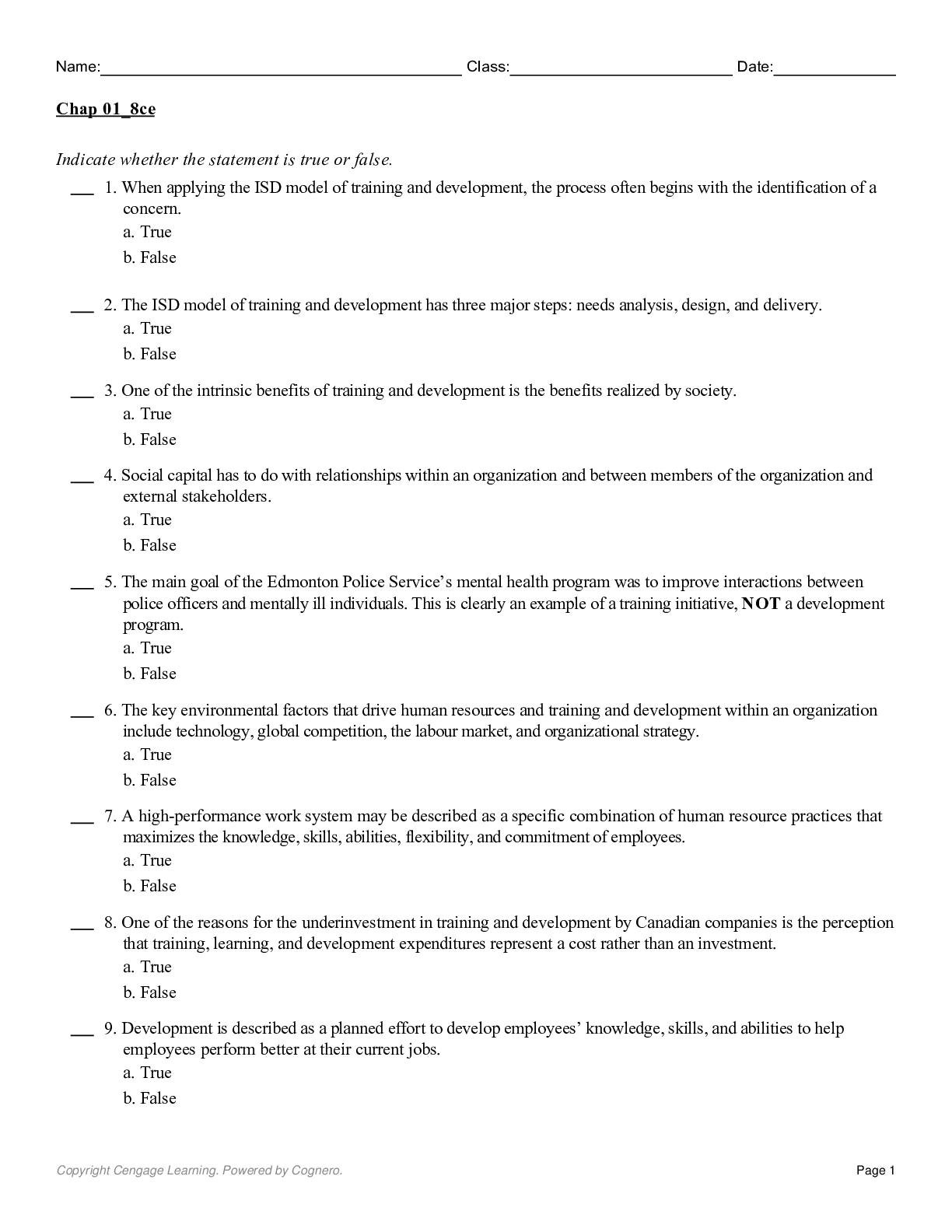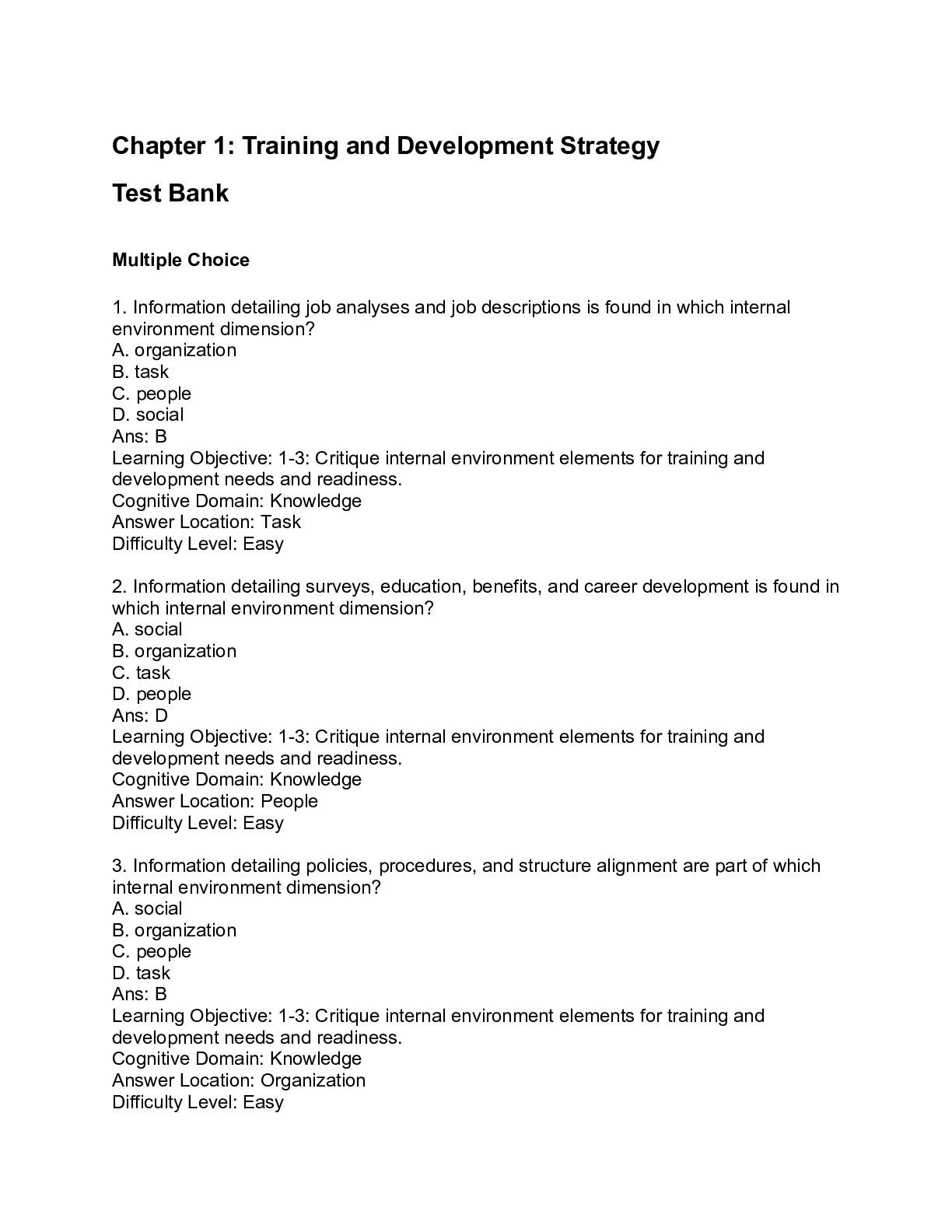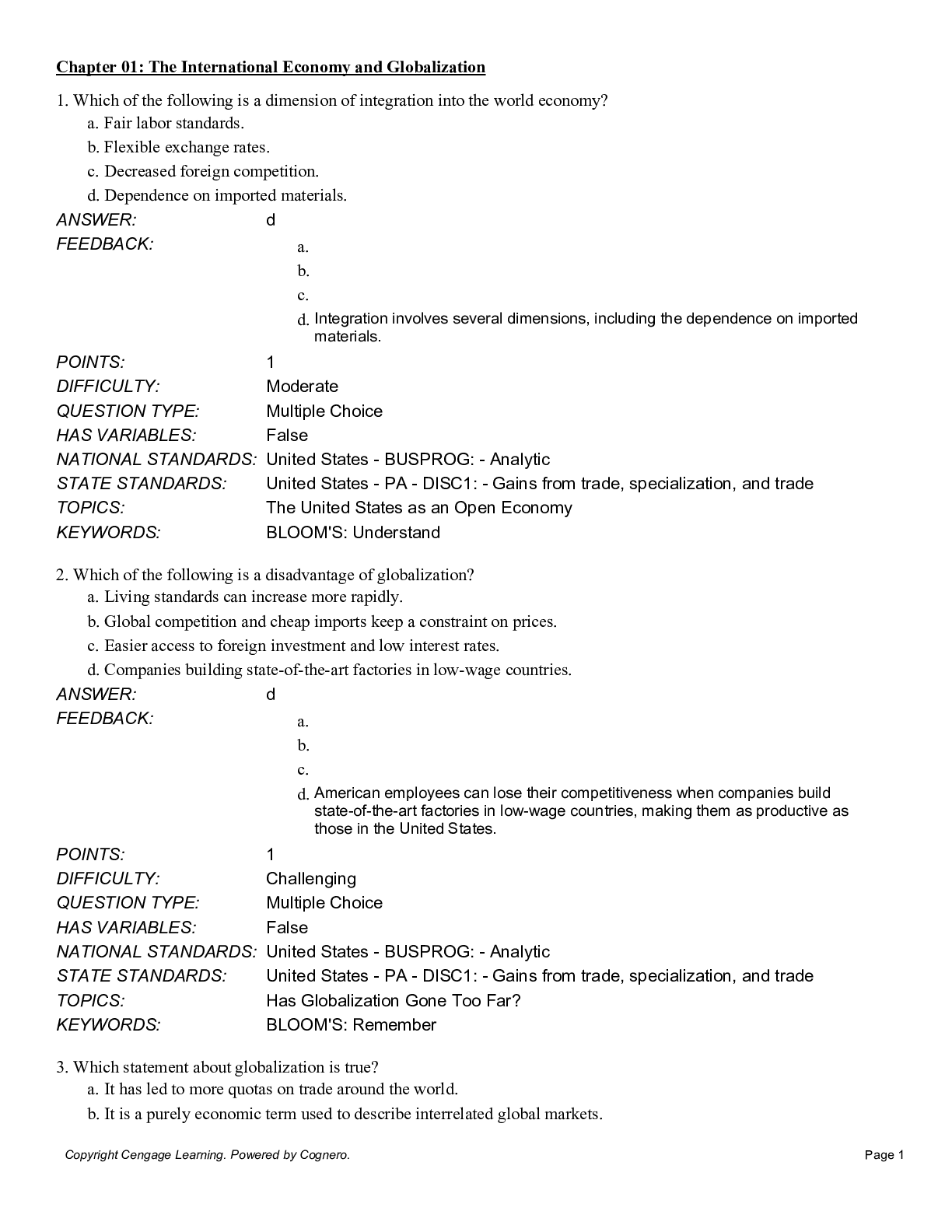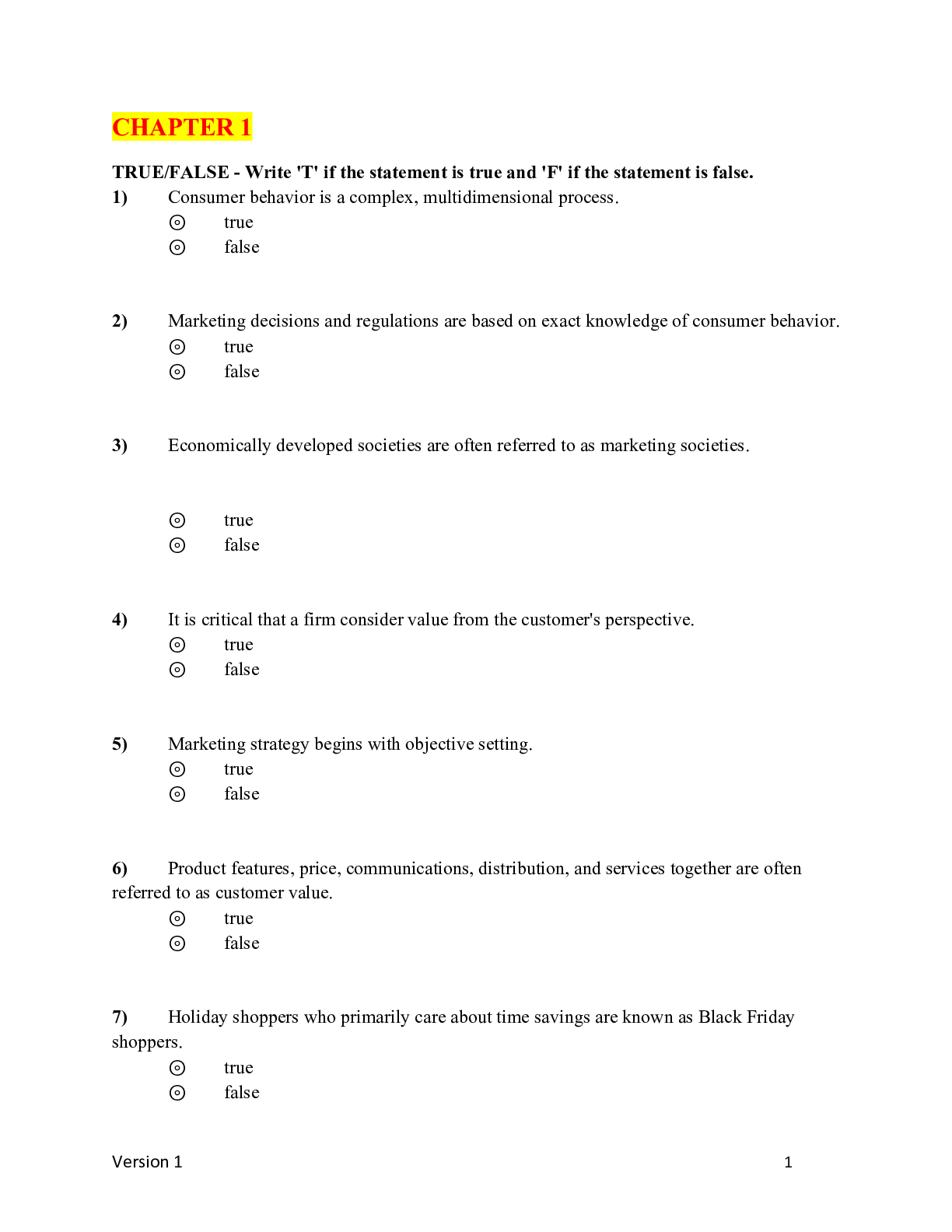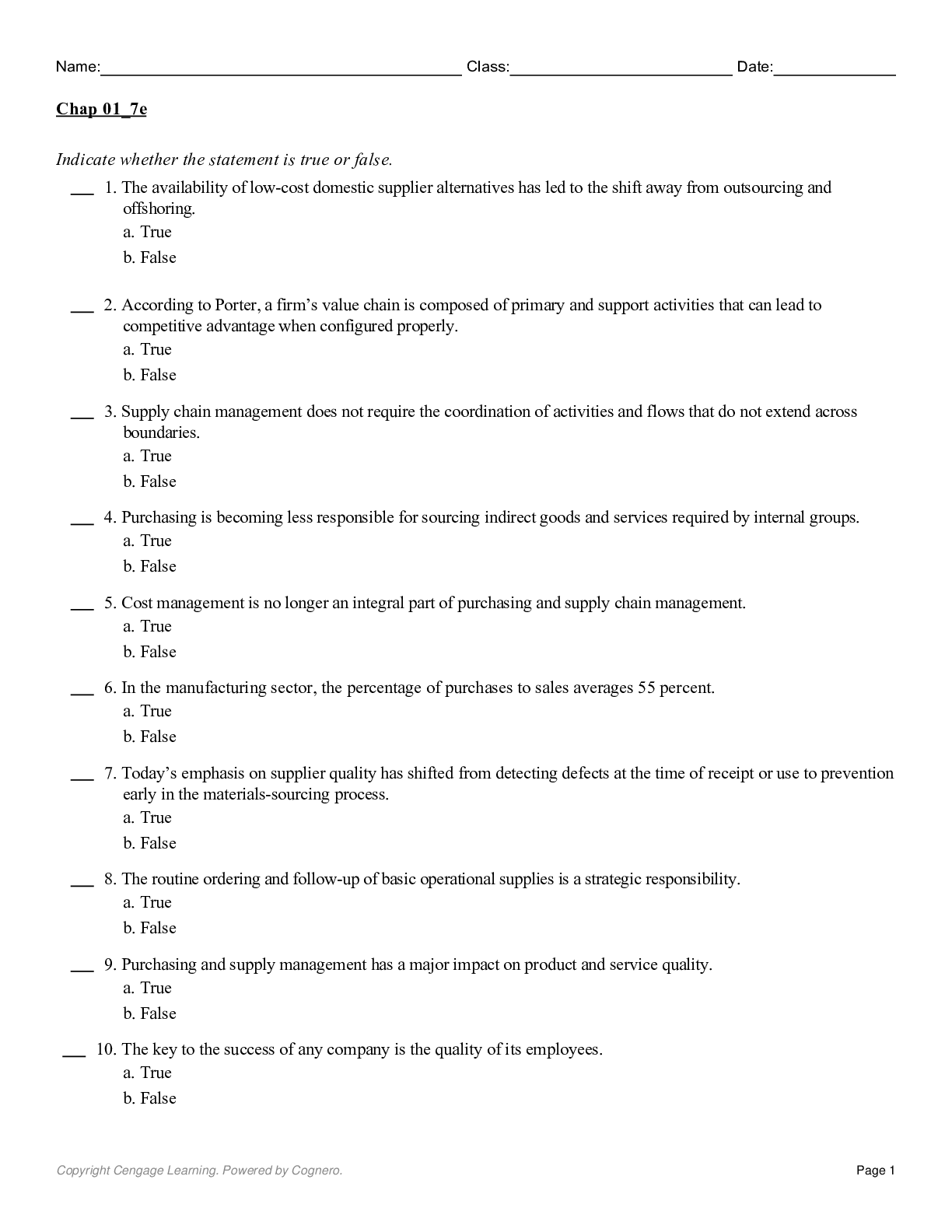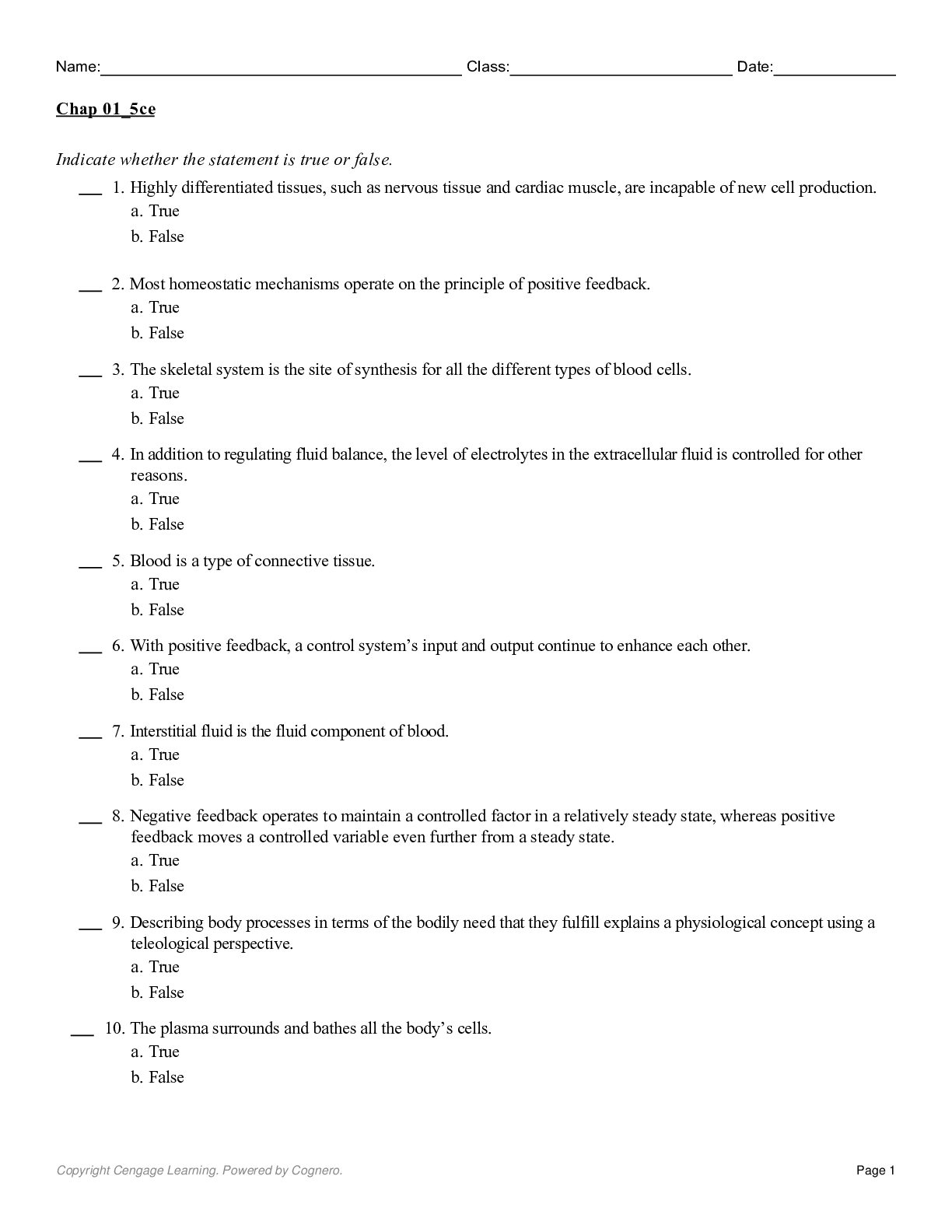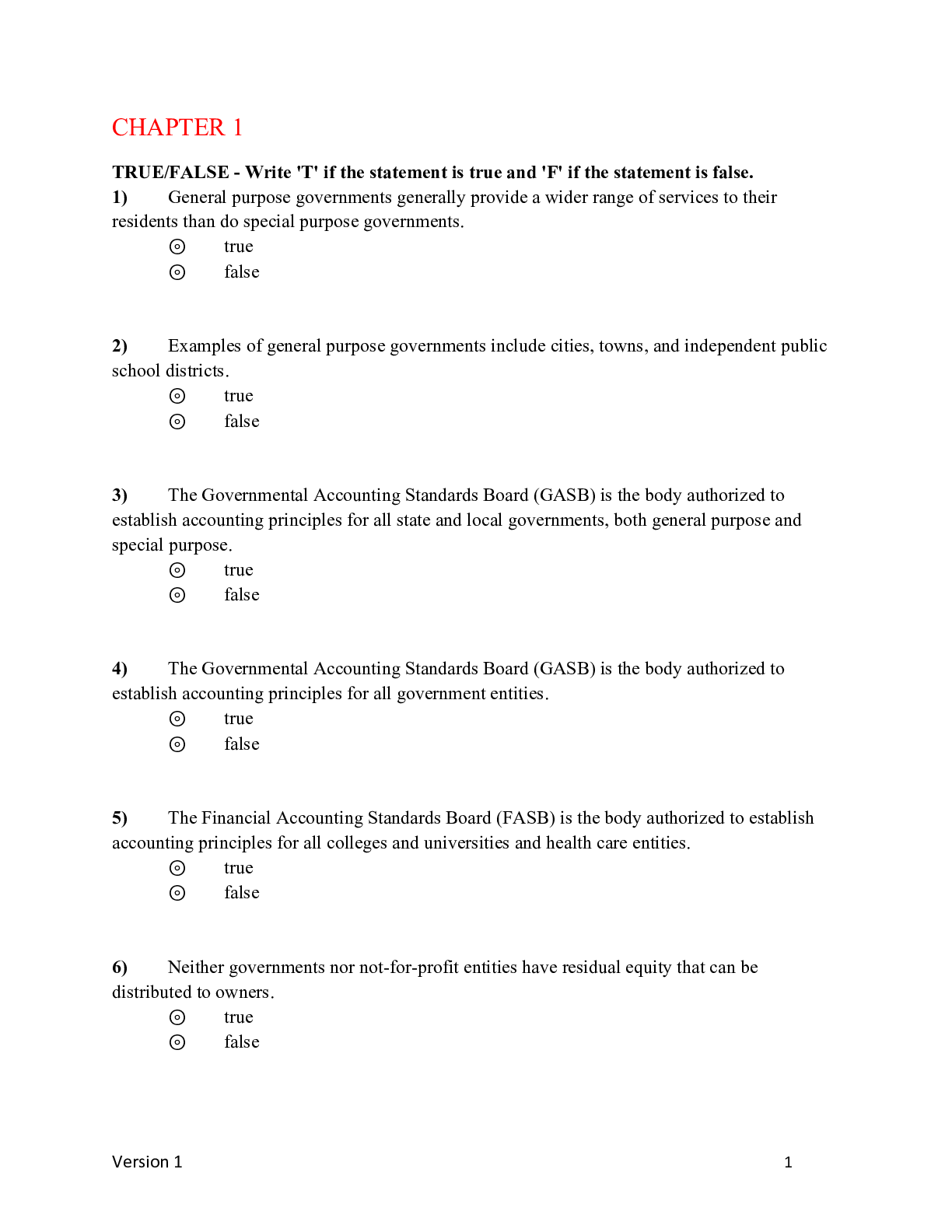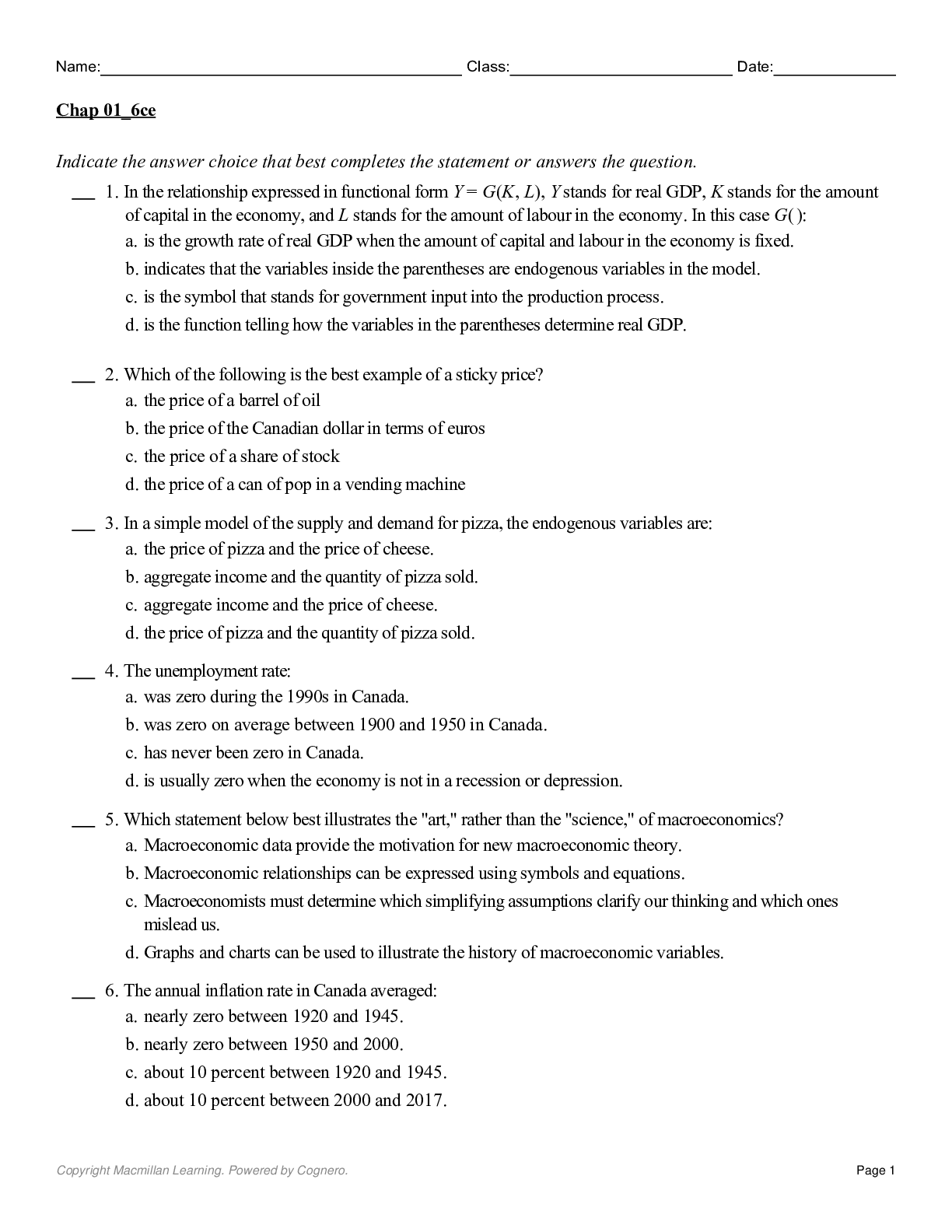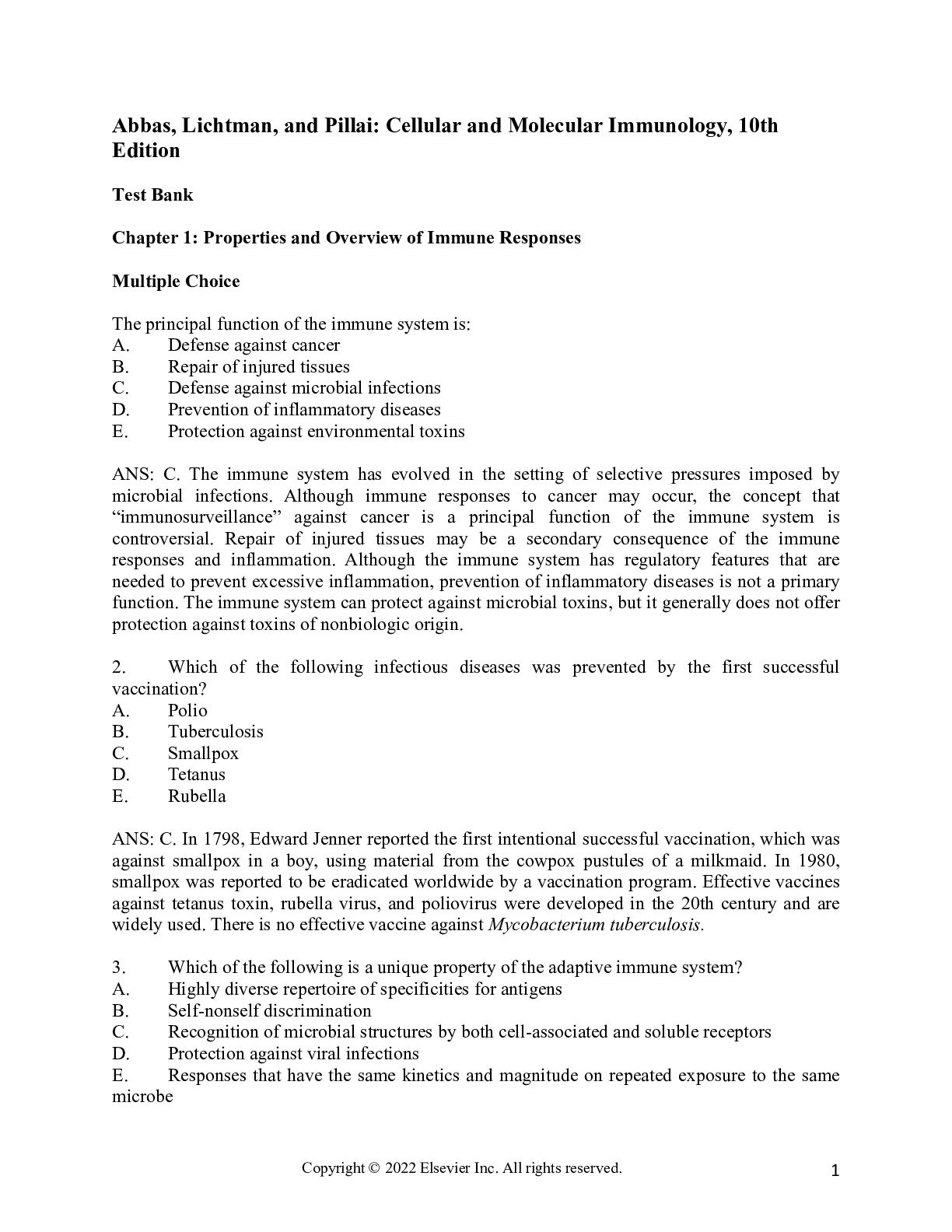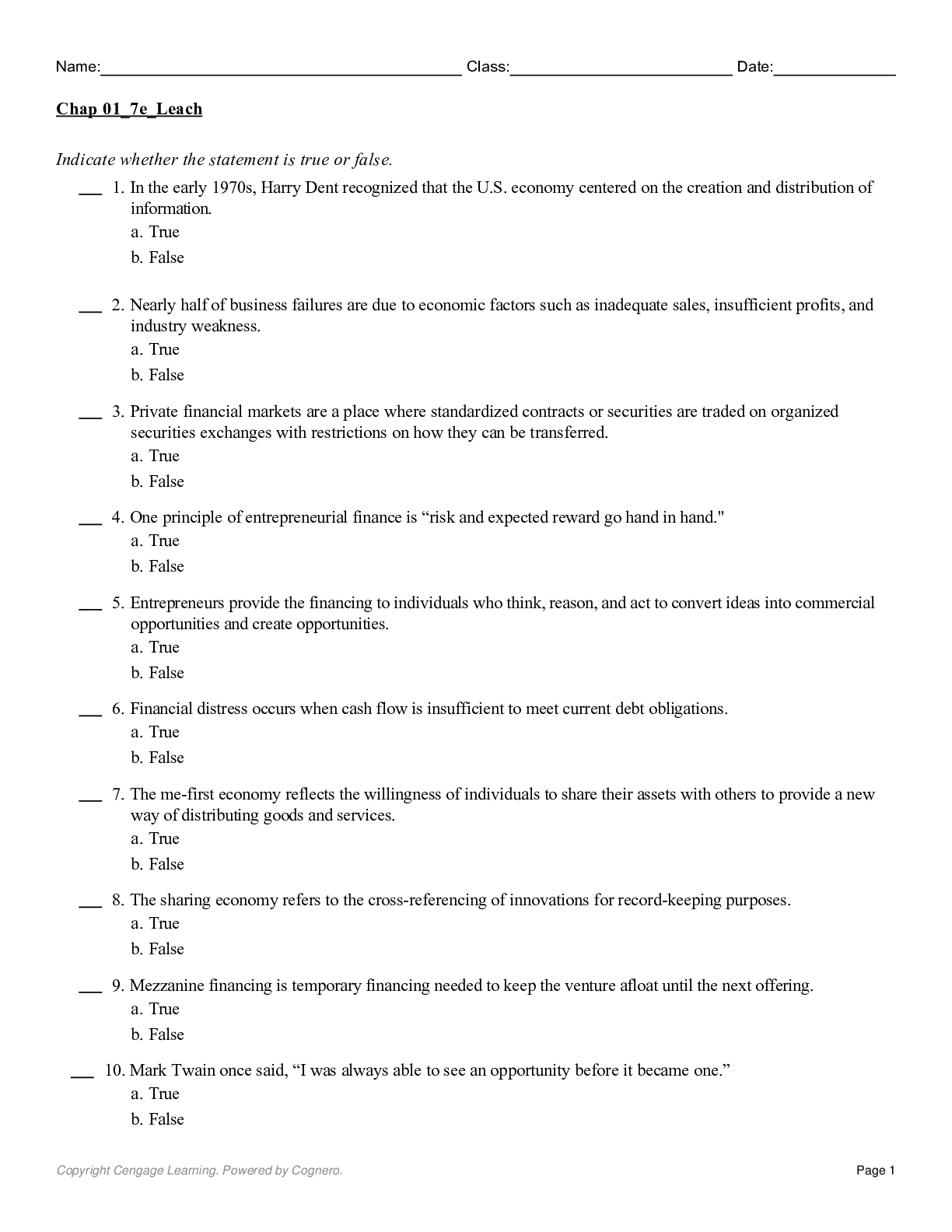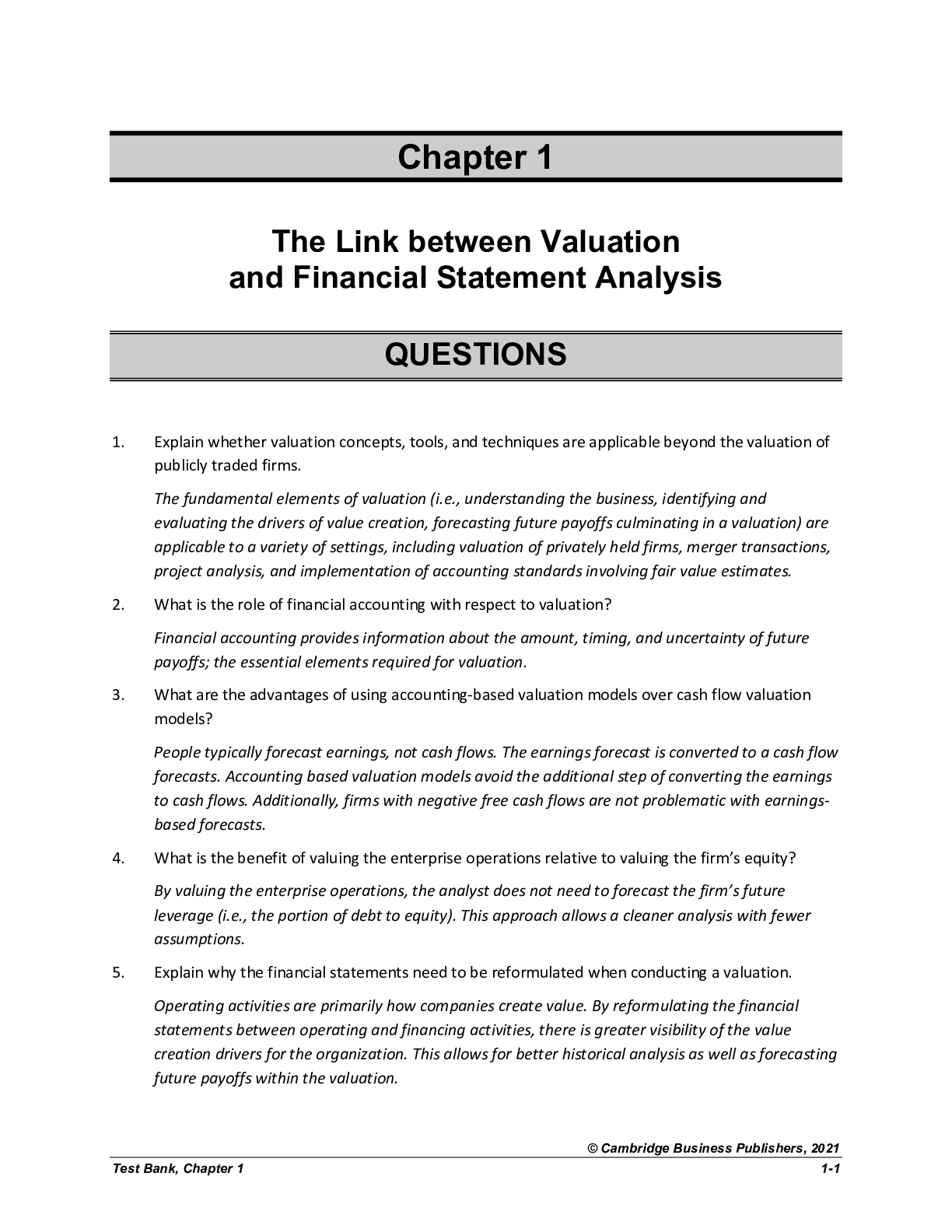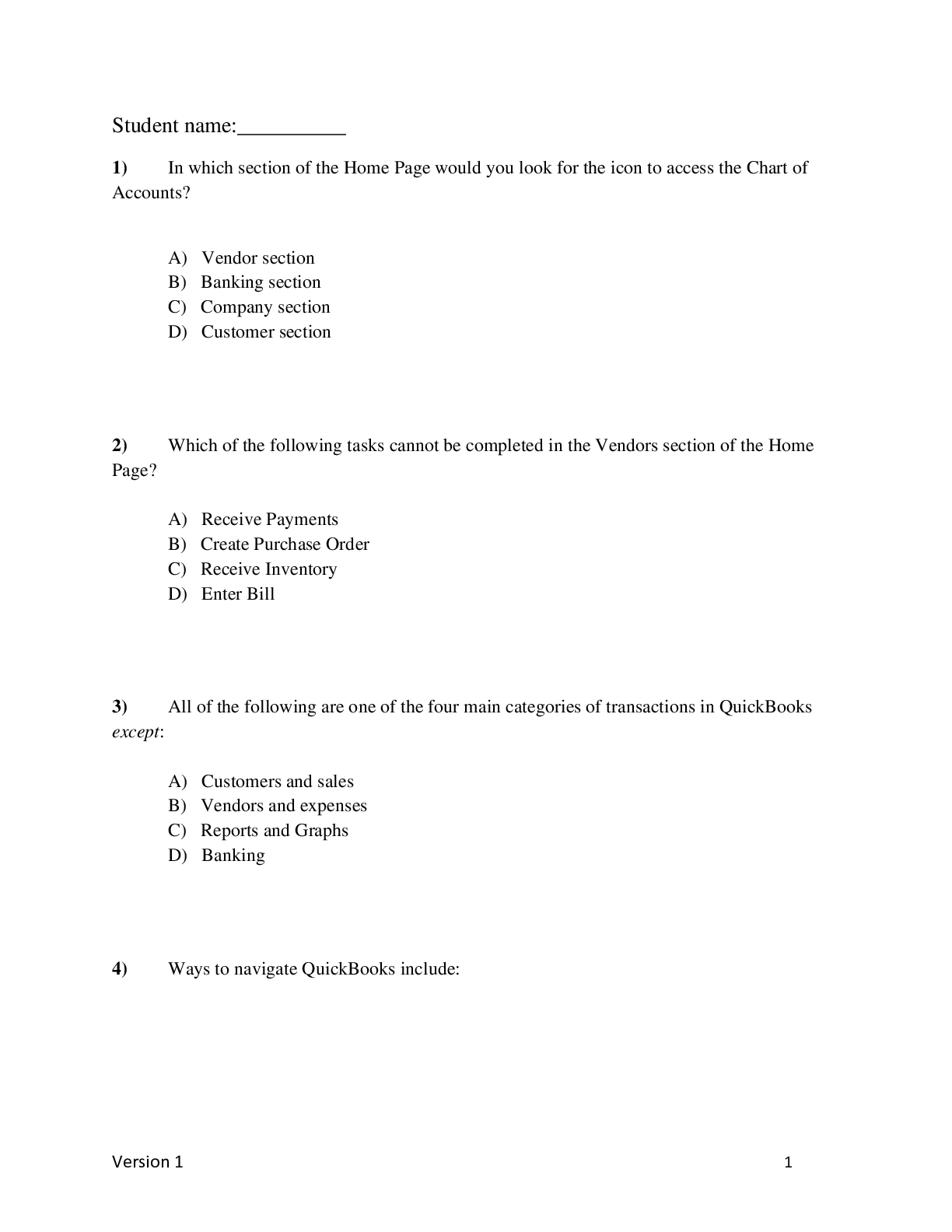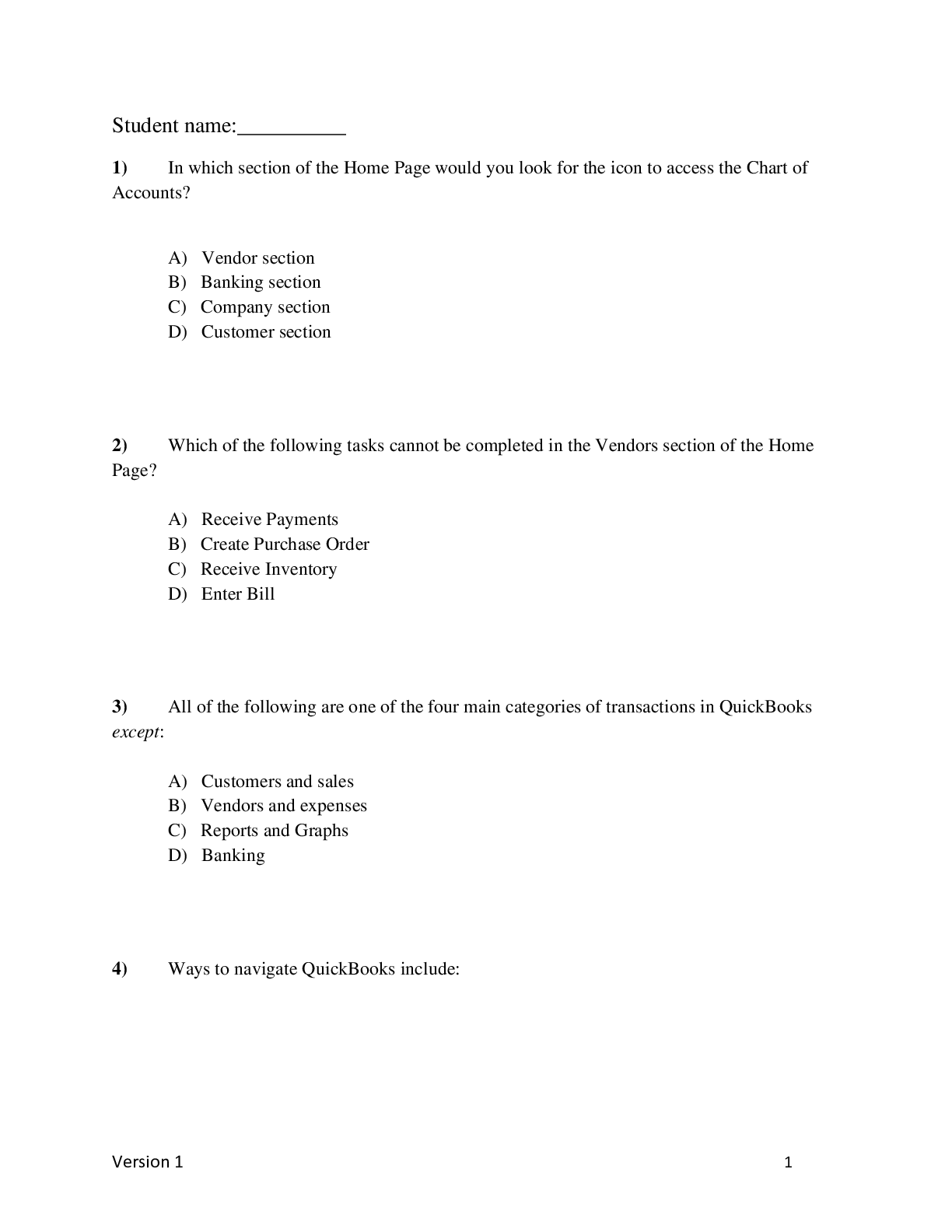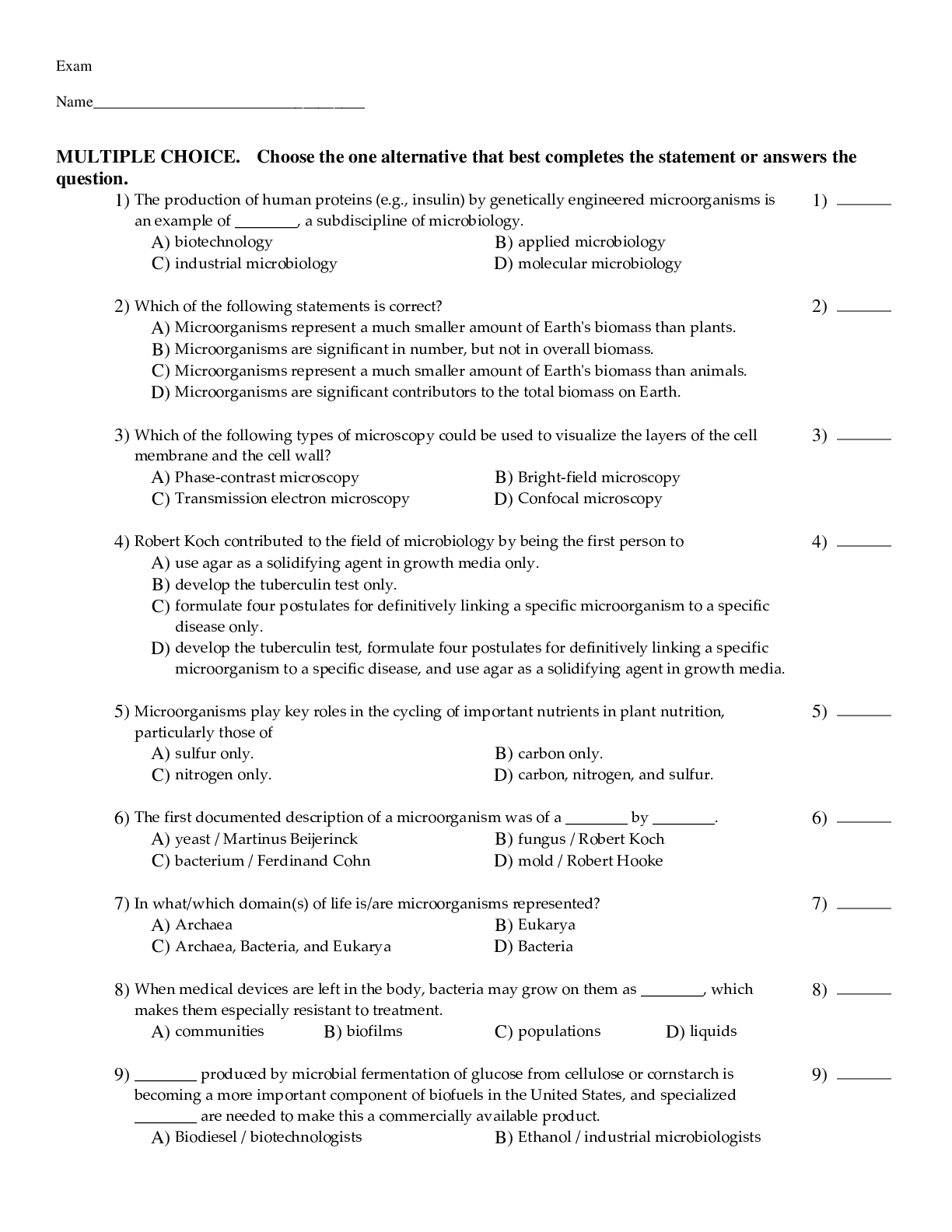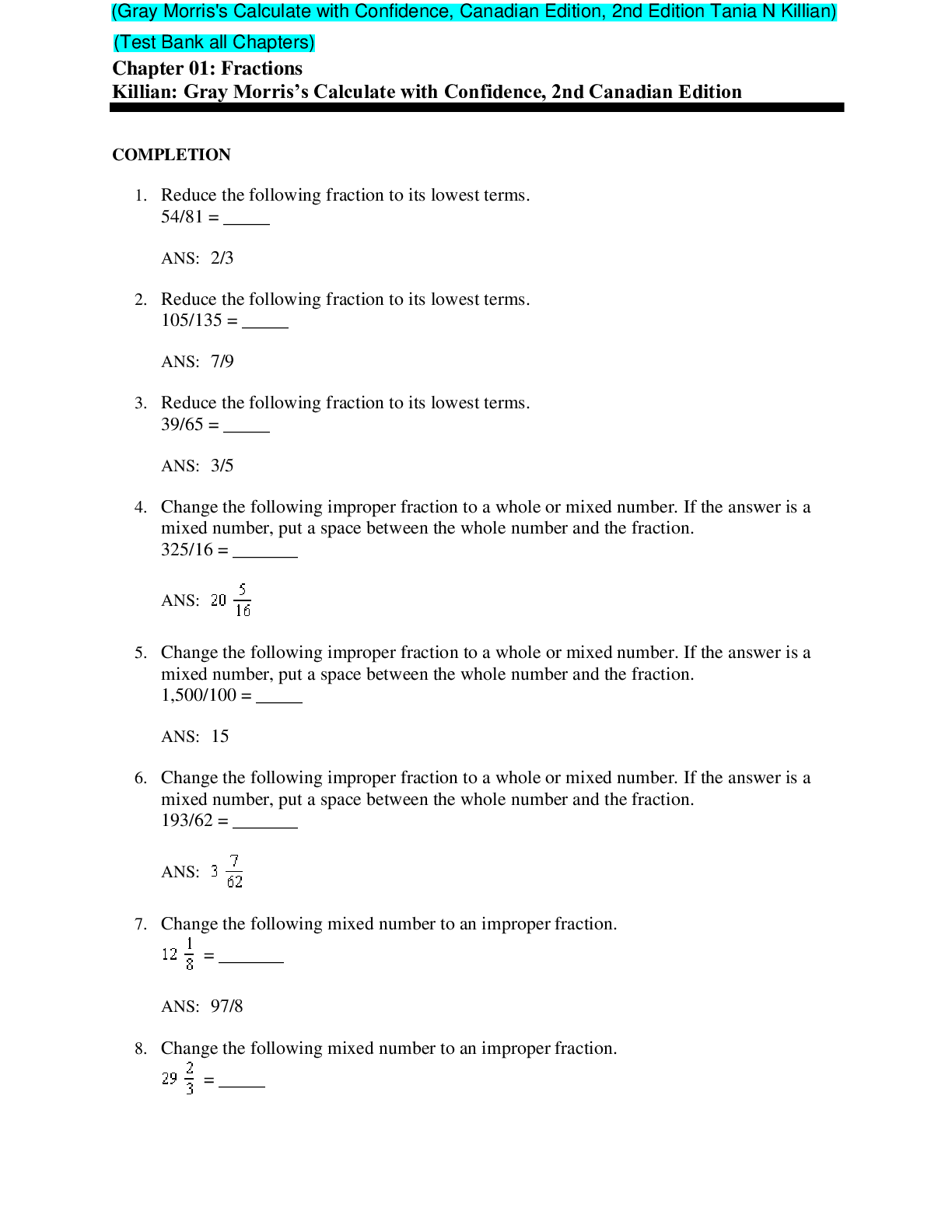Brock Biology of Microorganisms, 16E by Madigan Test Bank
Document Content and Description Below
Test Bank for Brock Biology of Microorganisms, 16E, 16th Edition by Michael T. Madigan,John M. Martinko,David A. Stahl,David P. Clark TEST BANK ISBN-13: 9780135845684 Full chapters included Unit ... 1 The Foundations of Microbiology 1 The Microbial World I Exploring the Microbial World 1.1 Microorganisms, Tiny Titans of the Earth 1.2 Structure and Activities of Microbial Cells Elements of Microbial Structure Genes, Genomes, Nucleus, and Nucleoid Activities of Microbial Cells 1.3 Cell Size and Morphology The Small World Surface-to-Volume Ratios, Growth Rates, and Evolution Major Morphologies of Prokaryotic Cells 1.4 An Introduction to Microbial Life Viruses 1.5 Microorganisms and the Biosphere A Brief History of Life on Earth Microbial Abundance and Activity in the Biosphere 1.6 The Impact of Microorganisms on Human Society Microorganisms as Agents of Disease Microorganisms, Agriculture, and Human Nutrition Microorganisms and Food Microorganisms and Industry II Microscopy and the Origins of Microbiology 1.7 Light Microscopy and the Discovery of Microorganisms 1.8 Improving Contrast in Light Microscopy Staining: Increasing Contrast for Bright-Field Microscopy Differential Stains: The Gram Stain Phase-Contrast and Dark-Field Microscopy Fluorescence Microscopy 1.9 Imaging Cells in Three Dimensions Differential Interference Contrast Microscopy Confocal Scanning Laser Microscopy 1.10 Probing Cell Structure: Electron Microscopy Transmission Electron Microscopy Scanning Electron Microscopy III Microbial Cultivation Expands the Horizon of Microbiology 1.11 Pasteur and Spontaneous Generation The Microbial Basis of Fermentation Spontaneous Generation Other Major Accomplishments of Pasteur 1.12 Koch, Infectious Diseases, and Pure Cultures The Germ Theory of Disease and Koch’s Postulates Koch, Pure Cultures, and Microbial Taxonomy Koch and Tuberculosis 1.13 Discovery of Microbial Diversity Sergei Winogradsky and Chemolithotrophy Martinus Beijerinck, the Enrichment Culture Technique, and Nitrogen Fixation IV Molecular Biology and the Unity and Diversity of Life 1.14 Molecular Basis of Life Unity in Biochemistry Cracking the Code of Life From DNA to Evolutionary Insight 1.15 Woese and the Tree of Life Early Attempts to Portray the Evolutionary History of Life Molecular Sequence Data Revolutionized Microbial Phylogeny The Tree of Life Based on rRNA Gene Sequences Revealing the Extent of Microbial Diversity Chapter Review I Exploring the Microbial World II Microscopy and the Origins of Microbiology III Microbial Cultivation Expands the Horizon of Microbiology IV Molecular Biology and the Unity and Diversity of Life Application Questions Chapter Glossary 2 Microbial Cell Structure and Function I The Cell Envelope 2.1 The Cytoplasmic Membrane Bacterial Cytoplasmic Membranes Archaeal Cytoplasmic Membranes Cytoplasmic Membrane Function 2.2 Transporting Nutrients into the Cell Active Transport and Transporters Simple Transporters and Group Translocation ABC Transporter Systems 2.3 The Cell Wall Bacterial Cell Walls Archaeal Cell Walls 2.4 LPS: The Outer Membrane Structure and Activity of LPS The Periplasm and Porins 2.5 Diversity of Cell Envelope Structure S-Layers Alternative Configurations of the Cell Envelope II Cell Surface Structures and Inclusions 2.6 Cell Surface Structures Capsules and Slime Layers Fimbriae, Pili, and Hami 2.7 Cell Inclusions Carbon Storage Polymers Polyphosphate, Sulfur, and Carbonate Minerals Gas Vesicles Magnetosomes 2.8 Endospores Endospore Formation and Germination Endospore Structure and Features The Sporulation Cycle III Cell Locomotion 2.9 Flagella, Archaella, and Swimming Motility Flagella and Flagellation Flagella Structure and Activity Flagellar Synthesis Archaella 2.10 Surface Motility Twitching Motility Gliding Motility 2.11 Chemotaxis Chemotaxis in Peritrichously Flagellated Bacteria Chemotaxis in Polarly Flagellated Bacteria Measuring Chemotaxis 2.12 Other Forms of Taxis Phototaxis Aerotaxis and Magnetotaxis IV Eukaryotic Microbial Cells 2.13 The Nucleus and Cell Division The Nucleus Cell Division 2.14 Mitochondria and Chloroplasts Mitochondria Chloroplasts The Endosymbiotic Origin of Organelles 2.15 Other Eukaryotic Cell Structures Cytoskeleton Endoplasmic Reticulum, the Golgi Complex, and Lysosomes Flagella and Cilia Chapter Review I The Cell Envelope II Cell Surface Structures and Inclusions III Cell Locomotion IV Eukaryotic Microbial Cells Application Questions Chapter Glossary 3 Microbial Metabolism I Fundamentals of Metabolism 3.1 Defining the Requirements for Life Free Energy Reducing Power Metabolic Classes of Microorganisms 3.2 Electron Transfer Reactions Redox Reactions and Reduction Potentials Electron Carriers and NAD+/NADH Cycling 3.3 Calculating Changes in Free Energy The Redox Tower and Its Relationship to ΔG0′ Calculating ΔG0′ from the Free Energy of Formation Calculating Free-Energy Change in Natural Conditions 3.4 Cellular Energy Conservation Adenosine Triphosphate Energy-Rich Compounds Mechanisms of Energy Conservation 3.5 Catalysis and Enzymes Enzymes Enzyme Catalysis II Catabolism: Chemoorganotrophs 3.6 Glycolysis, the Citric Acid Cycle, and the Glyoxylate Cycle Glycolysis The Citric Acid Cycle Biosynthesis and the Citric Acid Cycle Other Pathways for Chemoorganotrophy 3.7 Principles of Fermentation Energy Conservation and Redox Balance in Fermentation Fermentative Diversity 3.8 Principles of Respiration: Electron Carriers NADH Dehydrogenases and Flavoproteins Cytochromes, Other Iron Proteins, and Quinones 3.9 Principles of Respiration: Generating a Proton Motive Force Electron Transport Generation of the Proton Motive Force: Complexes I and II Complexes III and IV: bc1 and c- and a-Type Cytochromes ATP Synthase III Catabolism: Electron Transport and Metabolic Diversity 3.10 Anaerobic Respiration and Metabolic Modularity Respiration in Escherichia coli 3.11 Chemolithotrophy and Phototrophy Chemolithotrophy Phototrophy Generation of Reducing Power IV Biosynthesis 3.12 Autotrophy and Nitrogen Fixation The Calvin Cycle Nitrogen Fixation 3.13 Sugars and Polysaccharides Polysaccharide Biosyntheses and Gluconeogenesis Pentose Metabolism and the Pentose Phosphate Pathway 3.14 Amino Acids and Nucleotides Monomers of Proteins: Amino Acids Monomers of Nucleic Acids: Nucleotides 3.15 Fatty Acids and Lipids Fatty Acid Biosynthesis Lipid Biosynthesis Chapter Review I Fundamentals of Metabolism II Catabolism: Chemoorganotrophs III Catabolism: Electron Transport and Metabolic Diversity IV Biosynthesis Application Questions Chapter Glossary 4 Microbial Growth and Its Control I Culturing Microbes and Measuring Their Growth 4.1 Feeding the Microbe: Cell Nutrition Chemical Makeup of a Cell Carbon, Nitrogen, and Other Macronutrients Micronutrients: Trace Metals and Growth Factors 4.2 Growth Media and Laboratory Culture Classes of Culture Media Nutritional Requirements and Biosynthetic Capacity Laboratory Culture 4.3 Microscopic Counts of Microbial Cell Numbers Total Cell Count Microscopic Cell Counts in Microbial Ecology 4.4 Viable Counting of Microbial Cell Numbers Methods for Viable Counts Diluting a Sample Applications of the Plate Count Caveats to Plate-Counting Methods 4.5 Turbidimetric Measures of Microbial Cell Numbers Optical Density and Its Relationship to Cell Numbers Other Issues with Turbidimetric Growth Estimates II Dynamics of Microbial Growth 4.6 Binary Fission and the Microbial Growth Cycle The Microbial Growth Cycle Lag and Exponential Phases Stationary and Death Phases 4.7 Quantitative Aspects of Microbial Growth Plotting Growth Data The Mathematics of Bacterial Growth Specific Growth Rate Consequences of Exponential Growth 4.8 Continuous Culture The Chemostat and the Concept of Steady State Experimental Uses of the Chemostat 4.9 Biofilm Growth Biofilm Formation Biofilms and Humans 4.10 Alternatives to Binary Fission Budding Cell Division Hyphal Growth and Multiple Fission III Environmental Effects on Growth: Temperature 4.11 Temperature Classes of Microorganisms Cardinal Temperatures Temperature Classes of Organisms 4.12 Microbial Life in the Cold Cold Environments Psychrophilic and Psychrotolerant Microorganisms Molecular Adaptations to Life in the Cold 4.13 Microbial Life at High Temperatures Thermal Environments Hyperthermophiles and Thermophiles Protein and Membrane Stability at High Temperatures IV Environmental Effects on Growth: pH, Osmolarity, and Oxygen 4.14 Effects of pH on Microbial Growth Acidophiles Alkaliphiles Cytoplasmic pH and Buffers 4.15 Osmolarity and Microbial Growth Halophiles and Related Organisms Compatible Solutes 4.16 Oxygen and Microbial Growth Oxygen Classes of Microorganisms Culture Techniques for Aerobes and Anaerobes Why Is Oxygen Toxic? Superoxide Dismutase and Other Enzymes That Destroy Toxic Oxygen V Controlling Microbial Growth 4.17 General Principles and Microbial Growth Control by Heat Heat Sterilization The Autoclave and Pasteurization 4.18 Other Physical Control Methods: Radiation and Filtration Ultraviolet and Ionizing Radiation Filter Sterilization 4.19 Chemical Control of Microbial Growth Effect of Antimicrobial Agents on Growth Assaying Antimicrobial Activity Chemical Antimicrobial Agents Chapter Review I Culturing Microbes and Measuring Their Growth II Dynamics of Microbial Growth III Environmental Effects on Growth: Temperature IV Environmental Effects on Growth: pH, Osmolarity, and Oxygen V Controlling Microbial Growth Application Questions Chapter Glossary 5 Viruses and Their Multiplication I The Nature of Viruses 5.1 What Is a Virus? Viral Components and Activities Viral Diversity and Hosts 5.2 Structure of the Virion Virion Structure Virus Symmetry Enveloped Viruses Enzymes inside Virions 5.3 Culturing, Detecting, and Counting Viruses Detecting and Counting Viruses: The Plaque Assay Plating Efficiency in Estimates of Viral Titers II Overview of the Viral Replication Cycle 5.4 Steps in the Replication Cycle 5.5 Bacteriophage T4: A Model Lytic Virus Attachment and Entry of Bacteriophage T4 Penetration Production of T4 Virions and Release 5.6 Temperate Bacteriophages and Lysogeny 5.7 An Overview of Viruses of Eukaryotes Viral Infection of Animal Cells Animal Virion Assembly and Infection Outcomes Viral Infection of Plant Cells Chapter Review I The Nature of Viruses II Overview of the Viral Replication Cycle Application Questions Chapter Glossary Unit 2 Molecular Biology and Genetics 6 Molecular Information Flow and Protein Processing I Molecular Biology and Genetic Elements 6.1 DNA and Genetic Information Flow Properties of the Double Helix Size, Shape, and Supercoiling of DNA Genes and the Steps in Biological Information Flow 6.2 Genetic Elements: Chromosomes and Plasmids Chromosomal Gene Arrangements Plasmids II Copying the Genetic Blueprint: DNA Replication 6.3 Templates, Enzymes, and the Replication Fork Replication Enzymes Initiation of DNA Synthesis Leading and Lagging Strands and the Replication Process 6.4 Bidirectional Replication, the Replisome, and Proofreading The Replisome Fidelity of DNA Replication: Proofreading III RNA Synthesis: Transcription 6.5 Transcription in Bacteria RNA Polymerases and the Promoter Sequence Sigma Factors, Consensus Sequences, and Transcriptional Termination Units of Transcription and Polycistronic mRNA Termination of Transcription 6.6 Transcription in Archaea and Eukarya Archaeal and Eukaryotic RNA Polymerases, Promoters, and Terminators RNA Processing in Eukaryotes and Intervening Sequences in Archaea IV Protein Synthesis: Translation 6.7 Amino Acids, Polypeptides, and Proteins Composition Protein Diversity and Structures 6.8 Transfer RNA General Structure of Transfer RNA Recognition, Activation, and Charging of tRNAs 6.9 Translation and the Genetic Code Properties of the Genetic Code Start and Stop Codons and Reading Frames 6.10 The Mechanism of Protein Synthesis Ribosomes and the Initiation of Translation Elongation, Translocation, and Termination Role of Ribosomal RNA in Protein Synthesis Freeing Trapped Ribosomes and Trans-Translation V Protein Processing, Secretion, and Targeting 6.11 Assisted Protein Folding and Chaperones Major Chaperones of Bacteria Other Functions of Chaperones 6.12 Protein Secretion: The Sec and Tat Systems The Signal Sequence Sec and Tat Translocases 6.13 Protein Secretion: Gram-Negative Systems Types II and V Secretion Systems Types I, III, IV, and VI Secretion Systems Chapter Review I Molecular Biology and Genetic Elements II Copying the Genetic Blueprint: DNA Replication III RNA Synthesis: Transcription IV Protein Synthesis: Translation V Protein Processing, Secretion, and Targeting Application Questions Chapter Glossary 7 Microbial Regulatory Systems I DNA-Binding Proteins and Transcriptional Regulation 7.1 DNA-Binding Proteins Interaction of Proteins with Nucleic Acids Structure of DNA-Binding Proteins 7.2 Transcription Factors and Effectors Mechanisms of Transcription Factors Effector Molecules 7.3 Repression and Activation Enzyme Repression and Induction Mechanisms of Repression and Derepression Mechanisms of Activation Operons versus Regulons 7.4 Transcription Controls in Archaea Control of Nitrogen Assimilation in Archaea Dual-Acting Transcriptional Regulators in Archaea II Sensing and Signal Transduction 7.5 Two-Component Regulatory Systems Examples of Two-Component Regulatory Systems 7.6 Regulation of Chemotaxis Response to Signal Controlling Flagellar Rotation Adaptation Other Taxes 7.7 Cell-to-Cell Signaling Mechanism of Quorum Sensing Virulence Factors III Global Control 7.8 The lac Operon Catabolite Repression Cyclic AMP and Cyclic AMP Receptor Protein 7.9 Stringent and General Stress Responses Mechanism of the Stringent Response The Stringent Response and Microbial Ecology The General Stress Response: The RpoS Regulon 7.10 The Phosphate (Pho) Regulon Streptomyces and Phosphate Pathogenesis and the Pho Regulon 7.11 The Heat Shock Response Heat Shock Proteins The Alternative Sigma Factor RpoH IV RNA-Based Regulation 7.12 Regulatory RNAs Mechanisms of sRNA Activity Types of Small RNA 7.13 Riboswitches Mechanisms of Riboswitches Riboswitches and Evolution 7.14 Attenuation Attenuation in the Tryptophan Operon Mechanism of Attenuation V Regulation of Enzymes and Other Proteins 7.15 Feedback Inhibition 7.16 Post-Translational Regulation Regulation of PII Signal Transduction Proteins Inactivation of Sigma Factors Chapter Review I DNA-Binding Proteins and Transcriptional Regulation II Sensing and Signal Transduction III Global Control IV RNA-Based Regulation V Regulation of Enzymes and Other Proteins Application Questions Chapter Glossary 8 Molecular Aspects of Microbial Growth I Bacterial Cell Division 8.1 Visualizing Molecular Growth Fluorescent Tagging Super-Resolution Techniques 8.2 Chromosome Replication and Segregation Regulation of Chromosome Replication Initiation Genome Replication in Fast-Growing Cells Chromosome Segregation 8.3 Cell Division and Fts Proteins The Divisome Min Proteins and Cell Division 8.4 Determinants of Cell Morphology Cell Shape and MreB Crescentin Evolution of Cell Division and Cell Shape 8.5 Peptidoglycan Biosynthesis Insertion of New Peptidoglycan Transpeptidation Morphology-Related Proteins and Peptidoglycan Synthesis II Regulation of Development in Model Bacteria 8.6 Regulation of Endospore Formation Endospore Formation: Sporulation Factors Endospore Formation: Alternative Sigma Factors Nutrients for Endospore Formation 8.7 Regulation of Endospore Germination Triggers for Activating Endospore Germination Germination and Outgrowth Stages 8.8 Caulobacter Differentiation Regulatory Features Caulobacter and the Eukaryotic Cell Cycle 8.9 Heterocyst Formation in Anabaena Heterocyst Formation Regulation of Heterocyst Formation 8.10 Biofilm Formation Cyclic Di-GMP and Biofilm Formation Pseudomonas aeruginosa and Biofilms Vibrio cholerae and Biofilms Biofilms and Archaea III Antibiotics and Microbial Growth 8.11 Antibiotic Targets and Antibiotic Resistance Antibiotics That Target Major Molecular Processes Antibiotics That Target the Cell Membrane and Wall Antibiotic Resistance: Spontaneous Mutations and Antibiotic Modification Antibiotic Resistance: Efflux Pumps and Metabolic Bypasses 8.12 Persistence and Dormancy Toxin–Antitoxin Modules Steps to Dormancy Chapter Review I Bacterial Cell Division II Regulation of Development in Model Bacteria III Antibiotics and Microbial Growth Application Questions Chapter Glossary 9 Genetics of Bacteria and Archaea I Mutation 9.1 Mutations and Mutants Isolation of Mutants: Screening versus Selection Isolation of Nutritional Auxotrophs 9.2 Molecular Basis of Mutation Base-Pair Substitutions: Missense, Nonsense, and Silent Mutations Frameshifts and Other Insertions or Deletions 9.3 Reversions and Mutation Rates Reversions (Back Mutations) and Suppressors Mutation Rates 9.4 Mutagenesis Chemical Mutagens and Radiation DNA Repair and the SOS System II Gene Transfer in Bacteria 9.5 Genetic Recombination Molecular Events in Homologous Recombination Effect of Homologous Recombination on Genotype Complementation 9.6 Transformation Competence in Transformation Regulation of Competence 9.7 Transduction Generalized Transduction Lysogeny and Specialized Transduction Phage Conversion Gene Transfer Agents 9.8 Conjugation F Plasmid Mechanism of DNA Transfer during Conjugation 9.9 The Formation of Hfr Strains and Chromosome Mobilization Integration of F Plasmid and Chromosome Mobilization Transfer of Chromosomal Genes to the F Plasmid III Gene Transfer in Archaea and Other Genetic Events 9.10 Horizontal Gene Transfer in Archaea Examples of Archaeal Genetics Archaeal Competence and Viral Transfer Transfer by Cell-to-Cell Contact 9.11 Mobile DNA: Transposable Elements Insertion Sequences and Transposons Mechanisms of Transposition Utility of Transposon Mutagenesis 9.12 Preserving Genomic Integrity and CRISPR Bacterial and Archaeal Innate Immunity Adaptive Immunity and CRISPR Distribution of CRISPR Systems and Anti-CRISPR Systems Chapter Review I Mutation II Gene Transfer in Bacteria III Gene Transfer in Archaea and Other Genetic Events Application Questions Chapter Glossary Unit 3 Genomics, Synthetic Biology, and Evolution 10 Microbial Genomics and Other Omics I Genomics 10.1 Introduction to Genomics Genomics: Then and Now What Can Genomes Tell Us? 10.2 Sequencing and Annotating Genomes DNA Sequencing Genome Assembly and Annotation Finding and Identifying ORFs Genomic Analyses: The Final Tally 10.3 Genome Size and Gene Content in Bacteria and Archaea Small Genomes Large Genomes Gene Content of Bacterial Genomes 10.4 Organelle and Eukaryotic Microbial Genomes The Chloroplast Genome Mitochondrial Genomes and Proteomes Genomes and Introns in Some Microbial Eukaryotes II Functional Omics 10.5 Functional Genomics Functional Genomics and Heterologous Expression The Utility of Comparative Genomics: Discovery of New Antiphage Systems 10.6 High-Throughput Functional Gene Analysis: Tn-Seq 10.7 Metagenomics Examples of Metagenomic Studies Metagenomics and “Biome” Studies 10.8 Gene Chips and Transcriptomics Microarrays and the DNA Gene Chip Measuring Gene Expression and Other Uses of Gene Chips RNA-Seq Analysis 10.9 Proteomics and the Interactome Methods in Proteomics Utility of Proteomics: Profiling Protein Modifications The Interactome 10.10 Metabolomics Advances in Metabolomic Techniques: NIMS Utility of Metabolomics III Systems Biology 10.11 Single-Cell Genomics Cell Isolation and Sample Preparation Applications of Single-Cell Omics 10.12 Integrating Mycobacterium tuberculosis Omics Tuberculosis Gene Expression and Regulatory Networks Tuberculosis Proteomics and Metabolomics 10.13 Systems Biology and Human Health Chapter Review I Genomics II Functional Omics III Systems Biology Application Questions Chapter Glossary 11 Viral Genomics and Diversity I Viral Genomes and Classification 11.1 Size and Structure of Viral Genomes The Baltimore Scheme: DNA Viruses The Baltimore Scheme: RNA Viruses Hosts for Viruses of Each Baltimore Class Viral Protein Synthesis 11.2 Viral Taxonomy and Phylogeny Viral Taxonomy Viral Phylogeny II DNA Viruses 11.3 Single-Stranded DNA Bacteriophages: ϕX174 and M13 Bacteriophage ϕ X174 Bacteriophage M13 11.4 Double-Stranded DNA Bacteriophages: T4, T7, and Lambda Bacteriophage T4 Bacteriophage T7 Bacteriophage Lambda Lysis or Lysogeny: Regulation of the Lambda Lifestyle 11.5 Viruses of Archaea DNA Archaeal Viruses Genome Content of DNA Archaeal Viruses RNA Archaeal Viruses 11.6 Uniquely Replicating DNA Animal Viruses Pox Viruses Adenoviruses 11.7 DNA Tumor Viruses Polyomavirus SV40 Herpesviruses III RNA Viruses 11.8 Positive-Strand RNA Viruses Bacteriophage MS2 Poliovirus Coronaviruses 11.9 Negative-Strand RNA Animal Viruses Rabies Virus Influenza Virus 11.10 Double-Stranded RNA Viruses Reovirus Replication Reoviruses and RNA Replication 11.11 Viruses That Use Reverse Transcriptase Retroviruses and Integration into the Host Genome Hepadnaviruses IV Subviral Agents 11.12 Viroids Viroid Structure and Function Viroid Disease 11.13 Prions Prion Proteins and the Prion Infectious Cycle Nonpathogenic Prions Chapter Review I Viral Genomes and Classification II DNA Viruses III RNA Viruses IV Subviral Agents Application Questions Chapter Glossary 12 Biotechnology and Synthetic Biology I Tools of the Genetic Engineer 12.1 Manipulating DNA: PCR and Nucleic Acid Hybridization PCR and Polymerases PCR Applications and RT-PCR Gel Electrophoresis and Nucleic Acid Hybridization 12.2 Molecular Cloning An Overview of Gene Cloning and Restriction Enzymes Recombineering Cloning Vectors Hosts for Cloning Vectors 12.3 Expressing Foreign Genes in Bacteria Transcription and Translation of Cloned Genes Using Expression Vectors Cloning the Gene via mRNA or Artificial Synthesis Protein Stability and Purification 12.4 Molecular Methods for Mutagenesis Site-Directed Mutagenesis Cassette Mutagenesis and Gene Disruption 12.5 Reporter Genes and Gene Fusions Reporter Genes Gene Fusions II Making Products from Genetically Engineered Microbes: Biotechnology 12.6 Somatotropin and Other Mammalian Proteins Somatotropin Other Mammalian Proteins 12.7 Transgenic Organisms in Agriculture and Aquaculture The Ti Plasmid and Transgenic Plants Herbicide- and Insect-Resistant Plants Transgenic Fish 12.8 Engineered Vaccines and Therapeutic Agents Recombinant Vaccines, Vaccinia Virus, and Subunit Vaccines Commensal Bacteria and Therapeutic Delivery Pathogens as Engineered Anticancer Therapies Specific Delivery of Antibodies as an Anticancer Therapy 12.9 Mining Genomes and Engineering Pathways Environmental Gene Mining Pathway Engineering: The Indigo Synthesis Example 12.10 Engineering Biofuels Bacterial Conversion of Switchgrass to Ethanol Engineered Alkenes and Alkanes Microalgae and Biodiesel III Synthetic Biology and Genome Editing 12.11 Synthetic Metabolic Pathways, Biosensors, and Genetic Circuits Engineering a Major Food Product Synthetic Pharmaceuticals: Artemisinin and Malaria Biosensors and Genetic Circuits: Photographic Escherichia coli Biosensors and Genetic Circuits: Synchronized and Cyclical Drug Delivery 12.12 Synthetic Cells 12.13 Genome Editing and CRISPRs Sequence Targeting by the Cas9 Protein CRISPR Editing in Practice Gene Drives and Engineered Mosquitoes 12.14 Biocontainment of Genetically Modified Organisms Early Containment Schemes Rewiring the Genetic Code Chapter Review I Tools of the Genetic Engineer II Making Products from Genetically Engineered Microbes: Biotechnology III Synthetic Biology and Genome Editing Application Questions Chapter Glossary 13 Microbial Evolution and Genome Dynamics I Early Earth and the Origin and Diversification of Life 13.1 Formation and Early History of Earth Origin of Earth Origin of Cellular Life The Last Universal Common Ancestor 13.2 Photosynthesis and the Oxidation of Earth The Rise of Oxygen: Banded Iron Formations The Ozone Shield 13.3 Living Fossils: DNA Records the History of Life The Universal Tree of Life Horizontal Transfer and the Tree of Life 13.4 Endosymbiotic Origin of Eukaryotes The Last Eukaryotic Common Ancestor and Its Genetic Makeup Endosymbiotic Theory Formation of the Eukaryotic Cell 13.5 Viral Evolution Viruses as Selfish DNA Viruses as a Vestige of Pre-Cellular Life II Mechanisms of Microbial Evolution 13.6 The Evolutionary Process Origins of Genetic Diversity Selection and Genetic Drift Origins of Microbial Species 13.7 Experimental Evolution Loss of Function Gain of Function 13.8 Gene Families, Duplications, and Deletions Duplications and Gene Families Gene Deletions in Microbial Genomes Deletion Mutations and the Evolution of Interdependence in Microbial Communities 13.9 Horizontal Gene Transfer The Mobilome Detecting Horizontal Gene Flow 13.10 The Evolution of Microbial Genomes The Dynamic Nature of the Escherichia coli Genome Chromosomal Islands III Microbial Phylogeny and Systematics 13.11 Molecular Phylogeny: Making Sense of Molecular Sequences Obtaining DNA Sequences Sequence Alignment Phylogenetic Trees: Composition and Construction Limitations of Phylogenetic Trees 13.12 Microbial Systematics Phylogenetic Analyses Genomic Analyses Phenotypic Analyses The Description of New Species How Many Species of Bacteria and Archaea Exist? Chapter Review I Early Earth and the Origin and Diversification of Life II Mechanisms of Microbial Evolution III Microbial Phylogeny and Systematics Application Questions Chapter Glossary Unit 4 Microbial Diversity 14 Metabolic Diversity of Microorganisms I Introduction to Metabolic Diversity 14.1 Foundational Principles of Metabolic Diversity: Energy and Redox Conservation of Energy Chemotrophic Metabolism Reducing Power and Redox Balance Assimilative and Dissimilative Processes 14.2 Autotrophic Pathways The Calvin Cycle The Reverse Citric Acid Cycle Other Pathways of CO2 Fixation II Phototrophy 14.3 Photosynthesis and Chlorophylls Chlorophyll and Bacteriochlorophyll Reaction Centers and Antenna Pigments Photosynthetic Membranes, Chloroplasts, and Chlorosomes 14.4 Carotenoids and Phycobilins Carotenoids Phycobiliproteins and Phycobilisomes 14.5 Anoxygenic Photosynthesis Photosynthetic Electron Flow in Purple Bacteria Overview of Electron Flow in Anoxygenic Phototrophs 14.6 Oxygenic Photosynthesis Electron Flow and ATP Synthesis in Oxygenic Photosynthesis Anoxygenic Photosynthesis in Oxygenic Phototrophs III Respiratory Processes Defined by Electron Donor 14.7 Oxidation of Sulfur Compounds Energetics of Sulfur Oxidation Biochemistry of Sulfur Oxidation: The Sox System Other Aspects of Chemolithotrophic Sulfur Oxidation 14.8 Iron (Fe2+) Oxidation Iron-Oxidizing Bacteria Energy from Iron Oxidation Ferrous Iron Oxidation under Anoxic Conditions 14.9 Nitrification Bioenergetics and Enzymology of Ammonia and Nitrite Oxidation Carbon Metabolism and Ecology of Nitrifying Bacteria 14.10 Anaerobic Ammonia Oxidation (Anammox) The Anammoxosome and Its Reactions Ecology of Anammox IV Respiratory Processes Defined by Electron Acceptor 14.11 Nitrate Reduction and Denitrification Denitrifying Microorganisms and Their Ecological Activities Biochemistry of Dissimilative Nitrate Reduction 14.12 Sulfate and Sulfur Reduction Biochemistry and Energetics of Sulfate Reduction Special Metabolisms of Sulfate-Reducing Bacteria 14.13 Other Electron Acceptors Metal and Metalloid Reduction Organic and Halogenated Electron Acceptors V One-Carbon (C1) Metabolism 14.14 Acetogenesis Organisms and Pathway The Reductive Acetyl-CoA Pathway and Energy Conservation in Acetogenesis 14.15 Methanogenesis C1 Carriers in Methanogenesis Redox Coenzymes Methanogenesis from CO2+H2 Methanogenesis from Methyl Compounds and Acetate Autotrophy 14.16 Methanotrophy Aerobic Methane Oxidation C1 Assimilation by Aerobic Methanotrophs Anaerobic Oxidation of Methane (AOM) Intra-Aerobic Methanotrophy VI Fermentation 14.17 Energetic and Redox Considerations Energy-Rich Compounds and Substrate-Level Phosphorylation Achieving Redox Balance 14.18 Lactic and Mixed-Acid Fermentations Lactic Acid Fermentation Entner–Doudoroff Pathway Mixed-Acid Fermentations 14.19 Fermentations of Obligate Anaerobes Sugar Fermentation by Clostridium Species Amino Acid Fermentation by Clostridia and the Stickland Reaction Energy-Converting Hydrogenases 14.20 Secondary Fermentations Propionic Acid Fermentation Clostridium kluyveri Fermentation 14.21 Fermentations That Lack Substrate-Level Phosphorylation What Can Be Learned from the Decarboxylations of Succinate and Oxalate? 14.22 Syntrophy Interspecies Electron Transfer Energetics of H2 Transfer Ecology of Syntrophs VII Hydrocarbon Metabolism 14.23 Aerobic Hydrocarbon Metabolism Oxygenases and Aliphatic Hydrocarbon Oxidation Aromatic Hydrocarbon Oxidation 14.24 Anaerobic Hydrocarbon Metabolism Aliphatic Hydrocarbons Aromatic Hydrocarbons Chapter Review I Introduction to Metabolic Diversity II Phototrophy III Respiratory Processes Defined by Electron Donor IV Respiratory Processes Defined by Electron Acceptor V One-Carbon (C1) Metabolism VI Fermentation VII Hydrocarbon Metabolism Application Questions Chapter Glossary 15 Ecological Diversity of Bacteria I Ecological Diversity Among Microorganisms 15.1 Making Sense of Microbial Diversity II Ecological Diversity of Phototrophic Bacteria 15.2 Overview of Phototrophic Bacteria 15.3 Cyanobacteria Phylogeny and Classification of Cyanobacteria Physiology and Photosynthetic Membranes Cellular Structures and Motility Heterocysts and Nitrogen Fixation Ecology of Cyanobacteria 15.4 Purple Sulfur Bacteria 15.5 Purple Nonsulfur Bacteria and Aerobic Anoxygenic Phototrophs Purple Nonsulfur Bacteria Aerobic Anoxygenic Phototrophs 15.6 Green Sulfur Bacteria Pigments and Ecology Green Sulfur Bacteria Consortia 15.7 Green Nonsulfur Bacteria Other Chloroflexi 15.8 Other Phototrophic Bacteria Heliobacteria Phototrophic Acidobacteria Phototrophic Gemmatimonadetes III Diversity of Bacteria Defined by Metabolic Traits 15.9 Diversity of Nitrogen Fixers Symbiotic Diazotrophs Free-Living Diazotrophs Azotobacter and Alternative Nitrogenases 15.10 Diversity of Nitrifiers and Denitrifiers Physiology of Nitrifying Bacteria and Archaea Nitrifying Bacteria and Archaea: Ammonia Oxidizers Nitrifying Bacteria: Nitrite Oxidizers Denitrifying Bacteria and Archaea 15.11 Dissimilative Sulfur- and Sulfate-Reducers Dissimilative Sulfate-Reducers Physiology of Sulfate-Reducing Bacteria Ecology of Sulfate-Reducing Bacteria Dissimilative Sulfur-Reducers Physiology and Ecology of Sulfur-Reducing Bacteria 15.12 Dissimilative Sulfur-Oxidizers Physiological Diversity of Sulfur-Oxidizing Bacteria Thiobacillus and Achromatium Ecological Diversity and Strategies of Sulfide-Oxidizing Bacteria 15.13 Dissimilative Iron-Reducers Physiology Ecology 15.14 Dissimilative Iron-Oxidizers Acidophilic Aerobic Iron-Oxidizing Bacteria Neutrophilic Aerobic Iron-Oxidizing Bacteria Anaerobic Iron-Oxidizing Bacteria 15.15 Methanotrophs and Methylotrophs Aerobic Facultative Methylotrophs Aerobic Methanotrophs Physiology Ecology IV Morphologically and Ecologically Distinctive Bacteria 15.16 Microbial Predators Myxobacteria 15.17 Spirochetes 15.18 Budding and Prosthecate/Stalked Bacteria Budding Division Budding Bacteria: Hyphomicrobium Prosthecate and Stalked Bacteria Caulobacter 15.19 Sheathed Bacteria 15.20 Magnetic Microbes Chapter Review I Ecological Diversity Among Microorganisms II Ecological Diversity of Phototrophic Bacteria III Diversity of Bacteria Defined by Metabolic Traits IV Morphologically and Ecologically Distinctive Bacteria Application Questions Chapter Glossary 16 Phylogenetic Diversity of Bacteria I Proteobacteria 16.1 Alphaproteobacteria Other Groups of Alphaproteobacteria 16.2 Betaproteobacteria 16.3 Gammaproteobacteria: Enterobacteriales Fermentation Patterns in Enteric Bacteria Mixed-Acid Fermenters: Escherichia, Salmonella, Shigella, and Proteus Butanediol Fermenters: Enterobacter, Klebsiella, and Serratia 16.4 Gammaproteobacteria: Pseudomonadales and Vibrionales 16.5 Deltaproteobacteria and Epsilonproteobacteria Sulfur-Metabolizing Epsilonproteobacteria II Firmicutes, Tenericutes, and Actinobacteria 16.6 Firmicutes: Lactobacillales 16.7 Firmicutes: Nonsporulating Bacillales and Clostridiales 16.8 Firmicutes: Sporulating Bacillales and Clostridiales 16.9 Tenericutes: The Mycoplasmas Properties of Mycoplasmas Growth of Mycoplasmas Spiroplasma 16.10 Actinobacteria: Coryneform and Propionic Acid Bacteria Coryneform Bacteria Propionic Acid Bacteria 16.11 Actinobacteria: Mycobacterium 16.12 Filamentous Actinobacteria: Streptomyces and Relatives Ecology and Isolation of Streptomyces Antibiotics of Streptomyces III Bacteroidetes 16.13 Bacteroidales 16.14 Cytophagales, Flavobacteriales, and Sphingobacteriales IV Chlamydiae, Planctomycetes, and Verrucomicrobia 16.15 Chlamydiae Life Cycle of Chlamydiae Notable Genera of Chlamydiae 16.16 Planctomycetes Compartmentalization in Planctomycetes Planctomyces 16.17 Verrucomicrobia V Hyperthermophilic Bacteria 16.18 Thermotogae and Thermodesulfobacteria 16.19 Aquificae Aquifex and Autotrophy Thermocrinis VI Other Bacteria 16.20 Deinococcus–Thermus Radiation Resistance of Deinococcus radiodurans DNA Repair in Deinococcus radiodurans 16.21 Acidobacteria and Nitrospirae 16.22 Other Notable Phyla of Bacteria Chapter Review I Proteobacteria II Firmicutes, Tenericutes, and Actinobacteria III Bacteroidetes IV Chlamydiae, Planctomycetes, and Verrucomicrobia V Hyperthermophilic Bacteria VI Other Bacteria Application Questions Chapter Glossary 17 Diversity of Archaea I Euryarchaeota 17.1 Extremely Halophilic Archaea Hypersaline Environments: Chemistry and Productivity Taxonomy and Physiology of Extremely Halophilic Archaea Water Balance in Extreme Halophiles Halophilic Cytoplasmic Components Bacteriorhodopsin and Light-Mediated ATP Synthesis in Haloarchaea Other Rhodopsins 17.2 Methanogenic Archaea Diversity and Physiology of Methanogens Methanogenic Pathways Methanocaldococcus jannaschii as a Model Methanogen Methanopyrus, a Hyperthermophilic Methanogen 17.3 Thermoplasmatales Archaea Lacking Cell Walls Ferroplasma Picrophilus 17.4 Thermococcales and Archaeoglobales II Thaumarchaeota and Cryptic Archaeal Phyla 17.5 Thaumarchaeota and Nitrification in Archaea Physiological Characteristics of Thaumarchaeota Environmental Distribution of Thaumarchaeota 17.6 Nanoarchaeota and the “Hospitable Fireball” Nanoarchaeum and Its Host The Nanoarchaeum equitans Genome The DPANN Superphylum 17.7 Korarchaeota, the “Secret Filament” 17.8 Other Cryptic Archaeal Phyla Asgard Archaea Aigarchaeota and Bathyarchaeota III Crenarchaeota 17.9 Habitats and Energy Metabolism of Crenarchaeota 17.10 Crenarchaeota from Terrestrial Volcanic Habitats 17.11 Crenarchaeota from Submarine Volcanic Habitats IV Evolution and Life at High Temperature 17.12 An Upper Temperature Limit for Microbial Life What Is the Upper Temperature Limit for Life? Biochemical Problems at Supercritical Temperatures 17.13 Molecular Adaptations to Life at High Temperature Protein Folding and Thermostability Chaperones: Assisting Proteins to Remain in Their Native State DNA Stability: Solutes, Reverse Gyrase, and DNA-Binding Proteins Lipid and Ribosomal RNA Stability 17.14 Hyperthermophilic Archaea, H2, and Microbial Evolution Hyperthermophilic Habitats and H2 as an Energy Source Chapter Review I Euryarchaeota II Thaumarchaeota and Cryptic Archaeal Phyla III Crenarchaeota IV Evolution and Life at High Temperature Application Questions Chapter Glossary 18 Diversity of Microbial Eukarya I Organelles and Phylogeny of Microbial Eukarya 18.1 Endosymbioses and the Eukaryotic Cell Primary Endosymbioses Secondary Endosymbioses 18.2 Phylogenetic Lineages of Eukarya Eukaryotic Evolution: The Big Picture Phylogenetic Insights on Endosymbiosis II Protists 18.3 Excavates Diplomonads Parabasalids Kinetoplastids Euglenids 18.4 Alveolata Ciliates Dinoflagellates Apicomplexans 18.5 Stramenopiles Diatoms Oomycetes Golden Algae and Brown Algae 18.6 Rhizaria Chlorarachniophytes Foraminiferans Radiolarians 18.7 Haptophytes Coccolithophores Life Cycle 18.8 Amoebozoa Gymnamoebas and Entamoebas Slime Molds III Fungi 18.9 Fungal Physiology, Structure, and Symbioses Nutrition, Physiology, and Ecology Fungal Morphology, Spores, and Cell Walls Symbioses and Pathogenesis 18.10 Fungal Reproduction and Phylogeny Sexual Spores of Fungi The Phylogeny of Fungi 18.11 Microsporidia and Chytridiomycota 18.12 Mucoromycota and Glomeromycota 18.13 Ascomycota Mating Types and Sexual Reproduction in Saccharomyces 18.14 Basidiomycota Mushroom Development Pathogenic Basidiomycetes IV Archaeplastida 18.15 Red Algae Major Properties of Red Algae Cyanidium, Galdieria, and Relatives 18.16 Green Algae Very Small Green Algae and Colonial Green Algae Endolithic Phototrophs Chapter Review I Organelles and Phylogeny of Microbial Eukarya II Protists III Fungi IV Archaeplastida Application Questions Chapter Glossary Unit 5 Microbial Ecology and Environmental Microbiology 19 Taking the Measure of Microbial Systems I Culture-Dependent Analyses of Microbial Communities 19.1 Enrichment Culture Microbiology Inocula Enrichment Culture Outcomes The Winogradsky Column Enrichment Bias 19.2 Classical Procedures for Isolating Microbes Agar Dilution Tubes and the Most-Probable-Number Technique Criteria for Culture Purity 19.3 Selective Single-Cell Isolation: Laser Tweezers, Flow Cytometry, Microfluidics, and High-Throughput Methods Laser Tweezers and Flow Cytometry High-Throughput Culture and Microfluidic Devices II Culture-Independent Microscopic Analyses of Microbial Communities 19.4 General Staining Methods Fluorescent Staining with Dyes That Bind Nucleic Acids or Reveal Viability Fluorescent Proteins as Cell Tags and Reporter Genes 19.5 Microscopic Specificity: Fluorescence In Situ Hybridization (FISH) Phylogenetic Identification Using FISH Single-Cell Metabolic Activity Staining Using CARD-FISH and BONCAT-FISH III Culture-Independent Molecular Analyses of Microbial Communities 19.6 PCR Methods of Microbial Community Analysis PCR and Microbial Community Analysis Denaturing Gradient Gel Electrophoresis: Separating Very Similar Genes T-RFLP and ARISA Diversity Studies Using Clone Libraries or Next-Generation Sequencing Results of PCR Phylogenetic Analyses 19.7 Microarrays for Analysis of Microbial Phylogenetic and Functional Diversity 19.8 Environmental Multi-omics: Integration of Genomics, Transcriptomics, Proteomics, and Metabolomics Metagenomics and Reconstructing Environmental Genomes Some Examples of Environmental Genomics Metatranscriptomics, Metaproteomics, and Metabolomics Utility of Metaproteomics: An Environmental Case Study of Permafrost Utility of Metabolomics: An Environmental Case Study of Biocrusts IV Measuring Microbial Activities in Nature 19.9 Chemical Assays, Radioisotopic Methods, Microsensors, and Nanosensors Radioisotopes Acetylene as an Inhibitor and an Alternative Substrate Microsensors Sensor Nanoparticles for Spatially Resolved Chemical Imaging 19.10 Stable Isotopes and Stable Isotope Probing Isotopic Fractionation Use of Isotopic Fractionation in Microbial Ecology Stable Isotope Probing 19.11 Linking Functions to Specific Organisms Single-Cell Metabolisms Imaged by Secondary Ion Mass Spectrometry (SIMS) Raman Microspectroscopy Radioisotopes in Combination with FISH: Microautoradiography-FISH 19.12 Linking Genes and Cellular Properties to Individual Cells Flow Cytometry and Multiparametric Analyses Single-Cell Genomics A Preview of What’s to Come Chapter Review I Culture-Dependent Analyses of Microbial Communities II Culture-Independent Microscopic Analyses of Microbial Communities III Culture-Independent Molecular Analyses of Microbial Communities IV Measuring Microbial Activities in Nature Application Questions Chapter Glossary 20 Microbial Ecosystems I Microbial Ecology 20.1 General Ecological Concepts Ecosystems and Habitats Species Diversity in Microbial Habitats 20.2 Ecosystem Service: Biogeochemistry and Nutrient Cycles Energy Inputs to the Ecosystem Biogeochemical Cycling II The Microbial Environment 20.3 Environments and Microenvironments The Microorganism, Niches, and the Microenvironment Nutrient Levels and Growth Rates Microbial Competition and Cooperation 20.4 Surfaces and Biofilms Biofilms Why Bacteria Form Biofilms Biofilms on Microplastics Problem Biofilms for Humans 20.5 Microbial Mats Cyanobacterial Mats Iron-Rich Microbial Mats Chemolithotrophic Microbial Mats III Terrestrial Environments 20.6 Soils: General Properties Soil Composition Soil Formation Water Availability: Vegetated and Dryland Soils as Microbial Habitats Arid Soils 20.7 Prokaryotic Diversity in Soils Soil Bacterial and Archaeal Diversity Polluted Soils Climate and Disturbance Effects on Soil Microbes 20.8 The Terrestrial Subsurface Bacteria in the Deep Subsurface Archaea in the Deep Subsurface Growth Rates and the Future of Subsurface Microbiology IV Aquatic Environments 20.9 Freshwaters Oxygen Relationships in Freshwater Lakes Biochemical Oxygen Demand A Phylogenetic Snapshot of Freshwater Prokaryotic Diversity 20.10 Oxygen Relationships in the Marine Environment Tracking Seasonal Changes in Marine Microbial Composition Microbial Activities in Marine Environments and Oxygen Minimum Zones Oxygen-Depleted Marine Dead Zones and the Deepwater Horizon Catastrophe 20.11 Major Marine Phototrophs Primary Productivity: Prochlorococcus Other Pelagic Oxygenic Phototrophs Aerobic Anoxygenic Phototrophs 20.12 Pelagic Bacteria and Archaea Distribution and Activity of Archaea and Bacteria in Pelagic Waters Pelagibacter: The Most Abundant Bacterium Rhodopsins in Marine Microbes A Phylogenetic Snapshot of Marine Bacterial and Archaeal Diversity 20.13 Pelagic Marine Viruses Bacteriophages and Archaeal Viruses in Seawater Marine Viral Diversity Viruses as Agents of Genetic Transfer in the Marine Environment Auxiliary Metabolic Genes in Thaumarchaeota Survival Strategies of Viruses in Nature 20.14 The Deep Sea Conditions in the Deep Sea Piezotolerant and Piezophilic Bacteria and Archaea Molecular Effects of High Pressure 20.15 Deep-Sea Sediments Cell Numbers in Deep-Sea Sediments A Phylogenetic Snapshot of Marine Sediment Prokaryotic Diversity Energy Limitation and Microbial Life Below the Seafloor 20.16 Hydrothermal Vents Types of Vents Bacteria and Archaea in Hydrothermal Vents A Phylogenetic Snapshot of Hydrothermal Vent Prokaryotic Diversity Chapter Review I Microbial Ecology II The Microbial Environment III Terrestrial Environments IV Aquatic Environments Application Questions Chapter Glossary 21 Nutrient Cycles I Carbon, Nitrogen, and Sulfur Cycles 21.1 The Carbon Cycle Carbon Reservoirs Photosynthesis and Decomposition Methane Hydrates Carbon Balances and Coupled Cycles 21.2 Syntrophy and Methanogenesis Anoxic Decomposition and Syntrophy Methanogenic Symbionts and Acetogens in Termites 21.3 The Nitrogen Cycle Nitrogen Fixation and Denitrification Ammonification and Ammonia Fluxes Nitrification Anammox 21.4 The Sulfur Cycle Hydrogen Sulfide and Sulfate Reduction Sulfide and Elemental Sulfur Oxidation–Reduction Organic Sulfur Compounds II Other Nutrient Cycles 21.5 The Iron and Manganese Cycles: Reductive Activities Bacterial Reduction of Iron and Manganese Oxides Long-Range Electron Transfer to Insoluble Electron Acceptors Extracellular Electron Shuttles 21.6 The Iron and Manganese Cycles: Oxidative Activities Microbial Oxidation of Reduced Iron Microbial Oxidation of Reduced Manganese 21.7 The Phosphorus, Calcium, and Silicon Cycles Phosphorus and Phosphonates Calcium Silicon III Humans and Nutrient Cycling 21.8 Mercury Transformations Microbial Redox Cycle for Mercury Biochemistry of Mercury Methylation Mercury Resistance 21.9 Human Impacts on the Carbon and Nitrogen Cycles CO2, Other Trace Gases, and Global Warming CO2, and Its Effects on Aquatic Microbial Ecosystems Methane and Global Warming: Wetlands, Permafrost, and Sea Ice Anthropogenic Effects on the Nitrogen Cycle Chapter Review I Carbon, Nitrogen, and Sulfur Cycles II Other Nutrient Cycles III Humans and Nutrient Cycling Application Questions Chapter Glossary 22 Microbiology of the Built Environment I Mineral Recovery and Acid Mine Drainage 22.1 Mining with Microorganisms The Leaching Process Metal Recovery Other Microbial Leaching Processes: Uranium and Gold 22.2 Acid Mine Drainage II Bioremediation 22.3 Bioremediation of Uranium-Contaminated Environments Bioremediation of Uranium Bacterial Transformations of Uranium 22.4 Bioremediation of Organic Pollutants: Hydrocarbons Petroleum and Hydrocarbon Bioremediation Degradation of Stored Hydrocarbons 22.5 Bioremediation and Microbial Degradation of Major Chemical Pollutants: Chlorinated Organics and Plastics Catabolism of Organohalogens: The Chlorinated Organics Aerobic and Anaerobic Dechlorination Bioremediation of PCE and TCE Plastics III Wastewater and Drinking Water Treatment 22.6 Primary and Secondary Wastewater Treatment Wastewater and Sewage Primary Treatment: Physical Removal Processes Secondary Treatment: Activated Sludge and Trickling Filters 22.7 Tertiary Wastewater Treatment: Further Removal of Phosphorus and Nitrogen Biological Phosphorus Removal Biological Nitrogen Removal: The Conventional Nitrification–Denitrification Process Biological Nitrogen Removal: The Advanced Process of Nitritation–Denitrification Aerobic Granular Sludge Treatment 22.8 Sludge Processing and Contaminants of Emerging Concern Anaerobic Sludge Treatment Nitrogen Removal by Partial Nitritation–Anammox Contaminants of Emerging Concern 22.9 Drinking Water Purification and Stabilization Physical and Chemical Purification Disinfection 22.10 Water Distribution Systems The Microbiology of Municipal Water Distribution Systems IV Indoor Microbiology and Microbially Influenced Corrosion 22.11 The Microbiology of Homes and Public Spaces Microbiology of the Indoor Air in Private Dwellings Microbiology of Public Places 22.12 Microbially Influenced Corrosion of Metals Metal Corrosion by Sulfate-Reducing Bacteria Mechanisms of Metal Corrosion 22.13 Biodeterioration of Stone and Concrete Biodeterioration of Stone Building Materials Crown Corrosion of Wastewater Distribution Systems Chapter Review I Mineral Recovery and Acid Mine Drainage II Bioremediation III Wastewater and Drinking Water Treatment IV Indoor Microbiology and Microbially Influenced Corrosion Application Questions Chapter Glossary 23 Microbial Symbioses with Microbes, Plants, and Animals I Symbioses Between Microorganisms 23.1 Lichens Lichen Components Molecular Studies of Lichens 23.2 “Chlorochromatium aggregatum” Nature of the Consortium Phylogeny and Metabolism of a Consortium 23.3 Methanotrophic Consortia: Direct Interspecies Electron Transfer Anaerobic Oxidation of Methane and Short-Chain Alkanes Sulfate-Reducing Bacteria as Partner Organisms in Anoxic Hydrocarbon Oxidations Direct Interspecies Electron Transfer (DIET) II Plants as Microbial Habitats 23.4 The Legume–Root Nodule Symbiosis Leghemoglobin and Cross-Inoculation Groups Steps in Root Nodule Formation Attachment and Infection Bacteroids Nodule Formation: nod Genes, Nod Proteins, and Nod Factors Biochemistry of Root Nodules Stem-Nodulating Rhizobia Nonlegume N2-Fixing Symbioses: Azolla–Anabaena and Alnus–Frankia 23.5 Mycorrhizae Classes of Mycorrhizae Arbuscular Mycorrhizae Benefits for the Plant 23.6 Agrobacterium and Crown Gall Disease The Ti Plasmid Recognition and T-DNA Transfer Genetic Engineering with the Ti Plasmid III Insects as Microbial Habitats 23.7 Heritable Symbionts of Insects Types of Heritable Symbionts Nutritional Significance of Obligate Intracellular Symbionts of Insects Genome Reduction and Gene Transfer Events 23.8 Defensive Symbioses The Rove Beetle The Leafcutter Ants The Gut Microbiome of Bees 23.9 Termites Termite Natural History and Biochemistry Bacterial Diversity and Lignocellulose Digestion in Higher Termites Acetogenesis and Nitrogen Fixation in the Termite Gut IV Other Invertebrates as Microbial Habitats 23.10 Bioluminescent Symbionts and the Squid Symbiosis Key Bioluminescent Genera and Biochemistry of Bioluminescence Mechanism and Ecology of Bioluminescence The Squid–Aliivibrio System as a Model Symbiosis Establishing the Squid–Aliivibrio Symbiosis Propagating the Symbiosis 23.11 Marine Invertebrates at Hydrothermal Vents and Cold Seeps Tube Worms, Mussels, and Giant Clams Other Invertebrate Symbionts Genomics and Hydrothermal Vent Symbioses 23.12 Entomopathogenic Nematodes Specificity of Entomopathogenic Nematodes for Their Symbionts and Insect Hosts The Nematode Life Cycle and Lethality Practical Applications of Entomopathogenic Nematodes 23.13 Reef-Building Corals Phototrophic Symbioses with Animals The Staghorn Coral Symbiosis Transmission, Specificity, and Benefits of the Symbiodinium–Coral Association Coral Bleaching—The Risk of Harboring a Phototrophic Symbiont in a Changing World V Mammalian Gut Systems as Microbial Habitats 23.14 Alternative Mammalian Gut Systems Plant Substrates Digestion Systems of Herbivores 23.15 The Rumen and Rumen Activities Rumen Anatomy Microbial Fermentation in the Rumen 23.16 Rumen Microbes and Their Dynamic Relationships Rumen Bacteria and Archaea Rumen Protists and Fungi Dynamics of the Rumen Microbial Community Dangerous and Protective Changes in the Rumen Microbial Community Chapter Review I Symbioses Between Microorganisms II Plants as Microbial Habitats III Insects as Microbial Habitats IV Other Invertebrates as Microbial Habitats V Mammalian Gut Systems as Microbial Habitats Application Questions Chapter Glossary Unit 6 Microbe-Human Interactions and the Immune System 24 Microbial Symbioses with Humans I Structure and Function of the Healthy Adult Gastrointestinal and Oral Microbiomes 24.1 Overview of the Human Microbiome Methodologies for Probing the Human Microbiome A Snapshot of the Human Microbiome 24.2 Gastrointestinal Microbiota The Stomach and Small Intestine Structure, Cell Numbers, and Retention Times in the Large Intestine Bacterial Diversity of the Large Intestine Products of Intestinal Microbiota The Gut Microbiome and “Educating” the Immune System 24.3 Oral Cavity and Airways Oral Microbial Diversity Oral Microenvironments and Their Microbiota Microenvironments of the Respiratory Tract II Urogenital Tract and Skin Microbiomes and the Human Viral Microbiome 24.4 Urogenital Tracts and Their Microbes 24.5 The Skin and Its Microbes Microbial Diversity of Skin Microenvironments Other Aspects of the Skin Microbiome 24.6 The Human Virome The Human Body and the Virome Bacteriophages and the Human Virome Function of the Human Virome III From Birth to Death: Development of the Human Microbiome 24.7 Human Study Groups and Animal Models Human Microbiome Study Groups The Mouse Model 24.8 Colonization, Succession, and Stability of the Gut Microbiota Microbial Community Structure and Function in the First Three Years of Life The Microbiology of Breastfeeding versus Formula Stability of the Adult Microbiome and Transitions with Age IV Disorders Attributed to the Human Microbiome 24.9 Syndromes Linked to the Gut Microbiota Diet and Gut Health Inflammatory Bowel Disease The Role of the Gut Microbiota in Obesity: Mouse Models The Gut Microbiota and Human Obesity 24.10 Syndromes Linked to the Oral, Skin, and Vaginal Microbiota Dental Caries and Periodontitis Acne Vulgaris Vaginal Conditions V Modulation of the Human Microbiome 24.11 Antibiotics and the Human Microbiome Clostridioides difficile Infections Fecal Transplants 24.12 Probiotics, Prebiotics, and Synbiotics Probiotics Prebiotics and Synbiotics Chapter Review I Structure and Function of the Healthy Adult Gastrointestinal and Oral Microbiomes II Urogenital Tract and Skin Microbiomes and the Human Viral Microbiome III From Birth to Death: Development of the Human Microbiome IV Disorders Attributed to the Human Microbiome V Modulation of the Human Microbiome Application Question Chapter Glossary 25 Microbial Infection and Pathogenesis I Human–Pathogen Interactions 25.1 Microbial Adherence Adherence Molecules Adherence Structures: Capsules, Fimbriae, Pili, and Flagella 25.2 Colonization and Invasion Growth of the Microbial Community: An Example from Human Dental Caries Invasion and Systemic Infection 25.3 Pathogenicity, Virulence, and Virulence Attenuation Virulence Attenuation 25.4 Genetics of Virulence and the Compromised Host Virulence in Salmonella: Pathogenicity Islands and Plasmids The Compromised Host II Enzymes and Toxins of Pathogenesis 25.5 Enzymes as Virulence Factors Tissue-Destroying Enzymes Enzyme Activities at the Host’s Mucosal Surface 25.6 AB-Type Exotoxins Diphtheria Exotoxin: Blockage of Protein Synthesis Neurological Exotoxins: Botulinum and Tetanus Toxins Cholera Enterotoxin: Intestinal Distress 25.7 Cytolytic and Superantigen Exotoxins Cytolytic Exotoxins Superantigen Exotoxins 25.8 Endotoxins Endotoxin Structure and Biology Limulus Amoebocyte Lysate Assay for Endotoxin Chapter Review I Human–Pathogen Interactions II Enzymes and Toxins of Pathogenesis Application Questions Chapter Glossary 26 Innate Immunity: Broadly Specific Host Defenses I Fundamentals of Host Defense 26.1 Basic Properties of the Immune System Principles of Innate Immunity Principles of Adaptive Immunity 26.2 Barriers to Pathogen Invasion Natural Host Resistance Infection Site and Tissue Specificity Physical and Chemical Barriers to Infection II Cells and Organs of the Immune System 26.3 The Blood and Lymphatic Systems Blood and Lymph Circulation Hematopoiesis 26.4 Leukocyte Production and Diversity Myeloid Cells—Monocytes and Granulocytes Lymphocytes III Phagocyte Response Mechanisms 26.5 Pathogen Challenge and Phagocyte Recruitment Microbial Invasion Tissue Damage and Chemokine Release 26.6 Pathogen Recognition and Phagocyte Signal Transduction Pathogen-Associated Molecular Patterns Pattern Recognition Receptors Signal Transduction in Phagocytes 26.7 Phagocytosis and Phagocyte Inhibition Phagocytosis and the Phagolysosome Inhibiting Phagocytes IV Other Innate Host Defenses 26.8 Inflammation and Fever Inflammatory Cells and Local Inflammation Fever Systemic Inflammation and Septic Shock 26.9 The Complement System Classical Complement Activation Mannose-Binding Lectin and Alternative Pathways 26.10 Innate Defenses Against Viruses Natural Killer Cells Interferons Chapter Review I Fundamentals of Host Defense II Cells and Organs of the Immune System III Phagocyte Response Mechanisms IV Other Innate Host Defenses Application Questions Chapter Glossary 27 Adaptive Immunity: Highly Specific Host Defenses I Principles of Adaptive Immunity 27.1 Specificity, Memory, Selection Processes, and Tolerance Immune Specificity and Memory T Cell Selection and Tolerance B Cell Selection and Tolerance 27.2 Immunogens and Classes of Immunity Immunogens and Antigen Binding Classes of Adaptive Immunity: Active and Passive II Antibodies 27.3 Antibody Production and Structural Diversity B Cells, Antibodies and Their Activities, and Memory Immunoglobulin G Structure and Function Other Immunoglobulin Classes and Their Functions Antigen Exposure, Immune Memory, and the Primary and Secondary Responses 27.4 Antigen Binding and the Genetics of Antibody Diversity Variable Domains and Antigen–Antibody Interaction Organization of Immunoglobulin Genes VDJ Recombination and Somatic Hypermutation III The Major Histocompatibility Complex (MHC) 27.5 MHC Proteins and Their Functions Class I and Class II MHC Proteins Antigen Processing and Presentation to T Cells 27.6 MHC Polymorphism, Polygeny, and Peptide Binding Polymorphism, Polygeny, and the Immune Barrier to Tissue Transplantation Peptide Antigen Binding IV T Cells and Their Receptors 27.7 T Cell Receptors: Proteins, Genes, and Diversity TCR Structure and Diversity T Cell Activation and Anergy Structural Similarities of Antigen-Binding Proteins 27.8 T Cell Subsets and Their Functions T-Cytotoxic Cells Different Classes of T-Helper Cells Chapter Review I Principles of Adaptive Immunity II Antibodies III The Major Histocompatibility Complex (MHC) IV T Cells and Their Receptors Application Questions Chapter Glossary 28 Immune Disorders and Antimicrobial Therapy I Disorders and Deficiencies of the Immune System 28.1 Allergy, Hypersensitivity, and Autoimmunity Immediate Hypersensitivity Delayed-Type Hypersensitivity Autoimmune Conditions Treating Autoimmunity 28.2 Superantigens and Immunodeficiency Superantigens Immunodeficiency II Vaccines and Immunotherapy 28.3 Vaccination Against Infectious Diseases The Nature of Vaccines Synthetic and Genetically Engineered Vaccines Nucleic Acid Vaccines and Plant-Based Vaccines 28.4 Immunotherapy Anticancer Vaccines Checkpoint Inhibitors Adoptive T Cell Transfer Immunotherapeutic Efficacy and the Gut Microbiome III Drug Treatments for Infectious Diseases 28.5 Antibacterial Drugs The Bacterial Cell Wall as a Drug Target Protein Synthesis as a Drug Target Nucleic Acid Synthesis as a Drug Target Other Antibacterial Drug Targets 28.6 Antimicrobial Drugs That Target Nonbacterial Pathogens Antiviral Drugs Drugs That Target Eukaryotic Pathogens 28.7 Antimicrobial Drug Resistance and New Treatment Strategies Antimicrobial Drug Resistance New Drugs and New Treatment Strategies Chapter Review I Disorders and Deficiencies of the Immune System II Vaccines and Immunotherapy III Drug Treatments for Infectious Diseases Application Questions Chapter Glossary Unit 7 Infectious Diseases 29 Diagnosing Infectious Diseases I Microbiology and the Healthcare Environment 29.1 The Clinical Microbiology Laboratory Laboratory Safety Biological Containment and Biosafety Levels 29.2 Healthcare-Associated Infections Mechanisms of Transfer of Healthcare-Associated Infections Common Causative Agents of HAIs II Isolating and Characterizing Infectious Microorganisms 29.3 Workflow in the Clinical Laboratory Collecting Specimens and Detecting and Culturing Pathogens Blood and Cerebrospinal Fluid Specimens Urinary Tract and Fecal Cultures Wounds and Abscesses Genital Specimens and Culture for Gonorrhea Culture of Anaerobic Pathogens 29.4 Choosing the Right Treatment Minimum Inhibitory Concentration Measuring Antimicrobial Susceptibility III Immunological and Molecular Tools for Disease Diagnosis 29.5 Immunoassays and Disease Serology and Antibody Titers Skin Tests Monoclonal Antibodies 29.6 Precipitation, Agglutination, and Immunofluorescence Precipitation Agglutination Immunofluorescence 29.7 Enzyme Immunoassays, Rapid Tests, and Immunoblots EIAs Rapid Tests Immunoblots 29.8 Nucleic Acid–Based Clinical Assays Nucleic Acid Hybridization and Amplification Quantitative PCR and Reverse Transcription PCR Qualitative PCR Chapter Review I Microbiology and the Healthcare Environment II Isolating and Characterizing Infectious Microorganisms III Immunological and Molecular Tools for Disease Diagnosis Application Questions Chapter Glossary 30 Epidemiology and Public Health I Principles of Epidemiology 30.1 The Language of Epidemiology Disease Incidence and Prevalence The Scope of Disease Stages of Disease Mortality, Morbidity, and DALY 30.2 The Host Community Coevolution of a Host and a Pathogen Herd Immunity 30.3 Infectious Disease Transmission and Reservoirs Modes of Disease Transmission Disease Carriers and Disease Reservoirs and Control 30.4 Characteristics of Disease Epidemics Epidemics Basic Reproduction Number (R0) II Public and Global Health 30.5 Public Health and Infectious Disease Controls Directed Against Common Vehicles and Major Reservoirs Immunization Isolation, Quarantine, and Surveillance Pathogen Eradication 30.6 Global Health Comparisons Infectious Disease in the Americas and Africa Travel to Endemic Areas III Emerging Infectious Diseases, Pandemics, and Other Threats 30.7 Emerging and Reemerging Infectious Diseases Emerging and Reemerging Diseases Emergence Factors The Emergence of Toxigenic Clostridioides difficile Addressing Emerging Diseases 30.8 Examples of Pandemics: HIV/AIDS, Cholera, and Influenza HIV/AIDS Cholera Pandemic (H1N1) 2009 and Future Influenza Pandemics 30.9 Public Health Threats from Microbial Weapons Characteristics of Microbial Weapons Smallpox and Anthrax Chapter Review I Principles of Epidemiology II Public and Global Health III Emerging Infectious Diseases, Pandemics, and Other Threats Application Questions Chapter Glossary 31 Person-to-Person Bacterial and Viral Diseases I Airborne Bacterial Diseases 31.1 Airborne Pathogens 31.2 Streptococcal Syndromes Scarlet and Rheumatic Fevers and Other Group A Streptococcal Syndromes Streptococcus pneumoniae 31.3 Diphtheria and Pertussis Diphtheria Pertussis 31.4 Tuberculosis and Leprosy Tuberculosis Leprosy 31.5 Meningitis and Meningococcemia Pathogen and Disease Syndromes Diagnosis, Treatment, and Vaccines II Airborne Viral Diseases 31.6 MMR and Varicella-Zoster Infections Measles and Rubella Mumps Chicken Pox and Shingles 31.7 The Common Cold Symptoms and Transmission of the Common Cold Treatment 31.8 Influenza Antigenic Drift and Antigenic Shift Symptoms and Treatment of Influenza Influenza Pandemics III Direct-Contact Bacterial and Viral Diseases 31.9 Staphylococcus aureus Infections Epidemiology and Pathogenesis Staphylococcus aureus Toxic Shock Diagnosis and Treatment and the MRSA Epidemic 31.10 Helicobacter pylori and Gastric Diseases The Helicobacter Infection Process H. pylori and Clinical Disease 31.11 Hepatitis Epidemiology Other Aspects of Hepatitis Syndromes 31.12 Ebola: A Deadly Threat Ebola: The Virus and Its Transmission Ebola: The Disease and Its Treatment IV Sexually Transmitted Infections 31.13 Gonorrhea, Syphilis, and Chlamydia Gonorrhea Syphilis and Yaws Stages of Syphilis Chlamydial Syndromes 31.14 Herpes Simplex Viruses (HSV) and Human Papillomavirus (HPV) Herpes Human Papillomavirus 31.15 Human Immunodeficiency Virus (HIV) and AIDS HIV and a Definition of AIDS Pathogenesis of HIV/AIDS Symptoms of HIV/AIDS Diagnosing HIV/AIDS Treatment of HIV/AIDS HIV/AIDS Prevention Chapter Review I Airborne Bacterial Diseases II Airborne Viral Diseases III Direct-Contact Bacterial and Viral Diseases IV Sexually Transmitted Infections Application Questions Chapter Glossary 32 Vectorborne and Soilborne Bacterial and Viral Diseases I Animal-Transmitted Viral Diseases 32.1 Rabies Virus and Rabies Symptoms and Pathology of Rabies Diagnosis, Treatment, and Prevention of Rabies 32.2 Hantavirus and Hantavirus Syndromes Symptoms and Pathology of Hantavirus Syndromes Epidemiology, Diagnosis, and Prevention of Hantavirus Syndromes II Arthropod-Transmitted Bacterial and Viral Diseases 32.3 Rickettsial Diseases The Typhus Group: Rickettsia prowazekii The Spotted Fever Group: Rickettsia rickettsii Ehrlichiosis and Tickborne Anaplasmosis Q Fever 32.4 Lyme Disease and Borrelia Pathology, Diagnosis, and Treatment of Lyme Disease Epidemiology and Prevention of Lyme Disease 32.5 Yellow Fever, Dengue Fever, Chikungunya, and Zika Yellow Fever Dengue Fever Zika and Chikungunya Disease 32.6 West Nile Fever WNV Transmission and Pathology Control and Epidemiology of WNV 32.7 Plague Pathology and Treatment of Plague Plague Epidemiology and Control III Soilborne Bacterial Diseases 32.8 Anthrax Discovery and Properties of Anthrax Forms of Human Anthrax Prevention and Vaccines 32.9 Tetanus and Gas Gangrene Biology and Epidemiology of Tetanus Pathogenesis of Tetanus Diagnosis, Control, Prevention, and Treatment of Tetanus Gas Gangrene Chapter Review I Animal-Transmitted Viral Diseases II Arthropod-Transmitted Bacterial and Viral Diseases III Soilborne Bacterial Diseases Application Questions Chapter Glossary 33 Waterborne and Foodborne Bacterial and Viral Diseases I Water as a Disease Vehicle 33.1 Agents and Sources of Waterborne Diseases Potable Water Recreational Waters 33.2 Public Health and Water Quality Coliforms and Water Quality Testing for Fecal Coliforms and the Importance of Escherichia coli Reporting Water Purity Data II Waterborne Diseases 33.3 Vibrio cholerae and Cholera Diagnosis, Treatment, and Prevention of Cholera 33.4 Legionellosis Pathogenesis, Diagnosis, and Treatment Epidemiology 33.5 Typhoid Fever and Norovirus Illness Typhoid Fever Norovirus Illness III Food as a Disease Vehicle 33.6 Food Spoilage and Food Preservation Food Spoilage Food Preservation and Fermentation 33.7 Foodborne Diseases and Food Epidemiology Foodborne Diseases and Microbial Sampling Foodborne Disease Epidemiology IV Food Poisoning 33.8 Staphylococcal Food Poisoning Staphylococcal Enterotoxins Disease Properties, Treatment, and Prevention 33.9 Clostridial Food Poisoning Clostridium perfringens Food Poisoning Botulism V Food Infection 33.10 Salmonellosis Pathogenesis and Epidemiology Diagnosis, Treatment, and Prevention 33.11 Pathogenic Escherichia coli Shiga Toxin–Producing Escherichia coli (STEC) Other Pathogenic Escherichia coli Diagnosis, Treatment, and Prevention 33.12 Campylobacter Epidemiology and Pathology Diagnosis, Treatment, and Prevention 33.13 Listeriosis Epidemiology Pathology Diagnosis, Treatment, and Prevention 33.14 Other Foodborne Infectious Diseases Viruses Protists and Other Agents Chapter Review I Water as a Disease Vehicle II Waterborne Diseases III Food as a Disease Vehicle IV Food Poisoning V Food Infection Application Questions Chapter Glossary 34 Eukaryotic Pathogens: Fungi, Protozoa, and Helminths I Fungal Infections 34.1 Pathogenic Fungi and Classes of Infection Common Fungal Pathogens Fungal Disease Classes and Treatment 34.2 Fungal Diseases: Mycoses Superficial Mycoses Subcutaneous Mycoses Systemic Mycoses II Visceral Parasitic Infections 34.3 Amoebae and Ciliates: Entamoeba, Naegleria, and Balantidium Amebic Dysentery Naegleria and Balantidium Infections 34.4 Other Visceral Parasites: Giardia, Trichomonas, Cryptosporidium, Toxoplasma, and Cyclospora Giardiasis Trichomoniasis Cryptosporidiosis, Toxoplasmosis, and Cyclosporiasis III Blood and Tissue Parasitic Infections 34.5 Plasmodium and Malaria Malarial Life Cycle Epidemiology, Diagnosis, Treatment, and Control 34.6 Leishmaniasis, Trypanosomiasis, and Chagas Disease Leishmaniasis Trypanosomiasis and Chagas Disease 34.7 Parasitic Helminths: Schistosomiasis and Filariases Schistosomiasis Filariases [Show More]
Last updated: 11 months ago
Preview 1 out of 664 pages
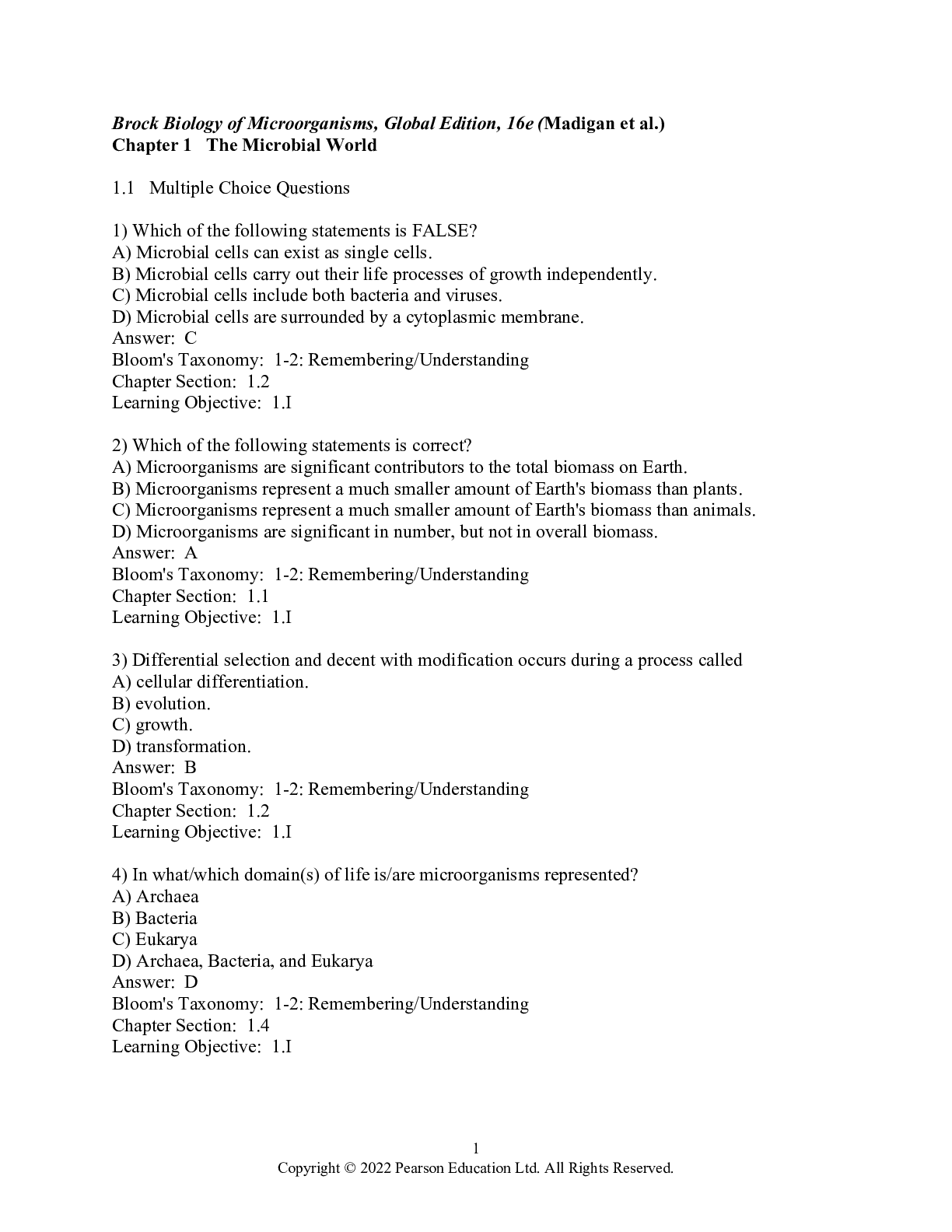
Reviews( 0 )
Document information
Connected school, study & course
About the document
Uploaded On
Aug 27, 2022
Number of pages
664
Written in
Additional information
This document has been written for:
Uploaded
Aug 27, 2022
Downloads
0
Views
120

